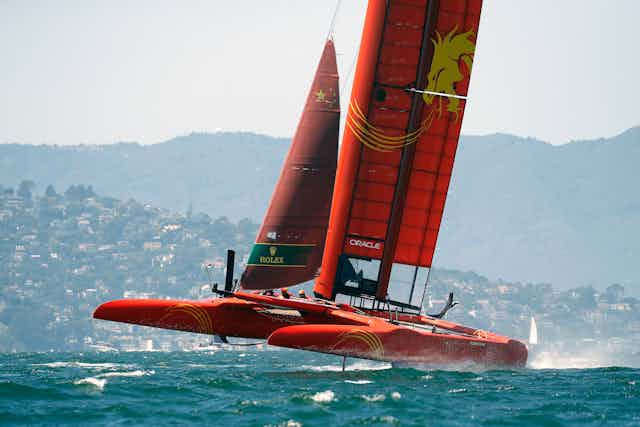

Sail GP: how do supercharged racing yachts go so fast? An engineer explains
Head of Engineering, Warsash School of Maritime Science and Engineering, Solent University
Disclosure statement
Jonathan Ridley does not work for, consult, own shares in or receive funding from any company or organisation that would benefit from this article, and has disclosed no relevant affiliations beyond their academic appointment.
View all partners
Sailing used to be considered as a rather sedate pastime. But in the past few years, the world of yacht racing has been revolutionised by the arrival of hydrofoil-supported catamarans, known as “foilers”. These vessels, more akin to high-performance aircraft than yachts, combine the laws of aerodynamics and hydrodynamics to create vessels capable of speeds of up to 50 knots, which is far faster than the wind propelling them.
An F50 catamaran preparing for the Sail GP series recently even broke this barrier, reaching an incredible speed of 50.22 knots (57.8mph) purely powered by the wind. This was achieved in a wind of just 19.3 knots (22.2mph). F50s are 15-metre-long, 8.8-metre-wide hydrofoil catamarans propelled by rigid sails and capable of such astounding speeds that Sail GP has been called the “ Formula One of sailing ”. How are these yachts able to go so fast? The answer lies in some simple fluid dynamics.
As a vessel’s hull moves through the water, there are two primary physical mechanisms that create drag and slow the vessel down. To build a faster boat you have to find ways to overcome the drag force.
The first mechanism is friction. As the water flows past the hull, a microscopic layer of water is effectively attached to the hull and is pulled along with the yacht. A second layer of water then attaches to the first layer, and the sliding or shearing between them creates friction.
On the outside of this is a third layer, which slides over the inner layers creating more friction, and so on. Together, these layers are known as the boundary layer – and it’s the shearing of the boundary layer’s molecules against each other that creates frictional drag.
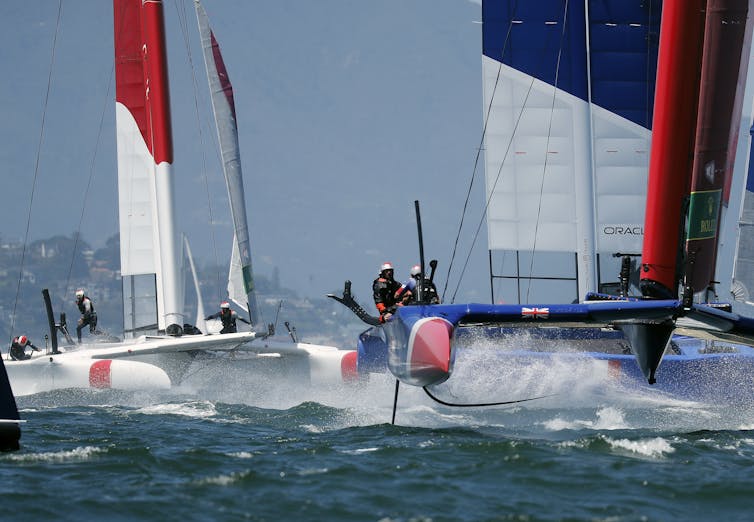
A yacht also makes waves as it pushes the water around and under the hull from the bow (front) to the stern (back) of the boat. The waves form two distinctive patterns around the yacht (one at each end), known as Kelvin Wave patterns.
These waves, which move at the same speed as the yacht, are very energetic. This creates drag on the boat known as the wave-making drag, which is responsible for around 90% of the total drag. As the yacht accelerates to faster speeds (close to the “hull speed”, explained later), these waves get higher and longer.
These two effects combine to produce a phenomenon known as “ hull speed ”, which is the fastest the boat can travel – and in conventional single-hull yachts it is very slow. A single-hull yacht of the same size as the F50 has a hull speed of around 12 mph.
However, it’s possible to reduce both the frictional and wave-making drag and overcome this hull-speed limit by building a yacht with hydrofoils . Hydrofoils are small, underwater wings. These act in the same way as an aircraft wing, creating a lift force which acts against gravity, lifting our yacht upwards so that the hull is clear of the water.

While an aircraft’s wings are very large, the high density of water compared to air means that we only need very small hydrofoils to produce a lot of the important lift force. A hydrofoil just the size of three A3 sheets of paper, when moving at just 10 mph, can produce enough lift to pick up a large person.
This significantly reduces the surface area and the volume of the boat that is underwater, which cuts the frictional drag and the wave-making drag, respectively. The combined effect is a reduction in the overall drag to a fraction of its original amount, so that the yacht is capable of sailing much faster than it could without hydrofoils.
The other innovation that helps boost the speed of racing yachts is the use of rigid sails . The power available from traditional sails to drive the boat forward is relatively small, limited by the fact that the sail’s forces have to act in equilibrium with a range of other forces, and that fabric sails do not make an ideal shape for creating power. Rigid sails, which are very similar in design to an aircraft wing, form a much more efficient shape than traditional sails, effectively giving the yacht a larger engine and more power.
As the yacht accelerates from the driving force of these sails, it experiences what is known as “ apparent wind ”. Imagine a completely calm day, with no wind. As you walk, you experience a breeze in your face at the same speed that you are walking. If there was a wind blowing too, you would feel a mixture of the real (or “true” wind) and the breeze you have generated.
The two together form the apparent wind, which can be faster than the true wind. If there is enough true wind combined with this apparent wind, then significant force and power can be generated from the sail to propel the yacht, so it can easily sail faster than the wind speed itself.
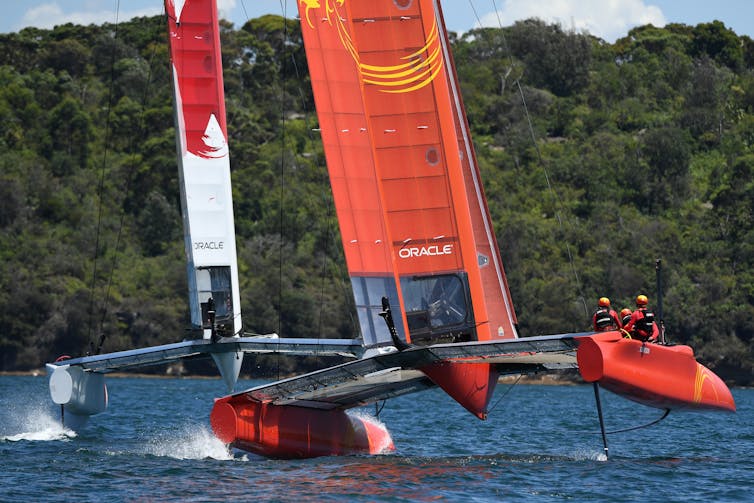
The combined effect of reducing the drag and increasing the driving power results in a yacht that is far faster than those of even a few years ago. But all of this would not be possible without one further advance: materials. In order to be able to “fly”, the yacht must have a low mass, and the hydrofoil itself must be very strong. To achieve the required mass, strength and rigidity using traditional boat-building materials such as wood or aluminium would be very difficult.
This is where modern advanced composite materials such as carbon fibre come in. Production techniques optimising weight, rigidity and strength allow the production of structures that are strong and light enough to produce incredible yachts like the F50.
The engineers who design these high-performance boats (known as naval architects ) are always looking to use new materials and science to get an optimum design. In theory, the F50 should be able to go even faster.
- Engineering
- Aerodynamics

Manager, Regional Training Hub

Head of Evidence to Action

Supply Chain - Assistant/Associate Professor (Tenure-Track)

OzGrav Postdoctoral Research Fellow

Casual Facilitator: GERRIC Student Programs - Arts, Design and Architecture
- Paddle Board

What Is the Average Speed of a Sailboat (Plus Its Top Speed)?
Sailing is a popular hobby and sport enjoyed by many enthusiasts around the world. The beauty of sailing lies in the challenge of mastering the wind and currents to move a boat forward. One of the fascinating aspects of sailing is its speed. Sailboats can move at varying speeds, depending on several factors. In this article, we will dive into the average and top speeds of sailboats and explore the techniques and strategies to increase sailboat speed.
Quick Facts
| Topic | Details |
|---|---|
| Sailboat Speed Dynamics | Determined by points of sail, wind direction, and boat design. |
| Factors Affecting Speed | Wind speed, sail area, boat size and weight, water friction, and boat design. |
| Measuring Speed | Via GPS, handheld speedometers, speed logs, timed performance, or wind instruments. |
| Types of Sailboats | Dinghies, Catamarans, Monohulls, Cruising Sailboats, and Racing Sailboats. |
| Average Speed (Dinghies) | 8-15 knots (9-17 mph). |
| Average Speed (Catamarans) | 15-25 knots (17-29 mph). |
| Average Speed (Monohulls) | 5-20 knots (6-23 mph). |
| Average Speed (Cruising Sailboats) | 5-15 knots (6-17 mph). |
| Average Speed (Racing Sailboats) | 20-30 knots (23-35 mph). |
| Increasing Speed | Optimizing sail trim, balancing the boat, reducing drag, and proper maintenance. |
| Sailboat Top Speeds | Influenced by wind speed, boat size and weight, sail area, and water conditions. |
| World Speed Record | Held by Sailrocket 2 at 68 mph. |
| Pushing to Limits | Requires experience, knowledge, skill, understanding of wind and water conditions, and prioritizing safety. |
Understanding Sailboat Speeds
Before delving into the average and top speeds of sailboats, you need to understand the dynamics of sailboat speeds. Sailboat speeds can be determined by the points of sail, wind direction, and boat design. Points of sail refer to the various angles at which a boat can sail in relation to the wind. These angles include upwind, close-hauled, beam reach, broad reach, and downwind (also called a run). Wind direction plays a crucial role in determining sailboat speed. A tailwind is usually faster than a headwind. The boat design also determines the speed potential of a sailboat.
When sailing upwind, sailboats move slower because they are fighting against the wind. Close-hauled sailing is the point of sail where the boat is sailing as close to the wind as possible. It is the slowest point of sail, as the boat is sailing against the wind. Beam reach sailing is when the boat is sailing perpendicular to the wind. It is faster than close-hauled sailing but slower than broad reach sailing. Broad reach sailing is when the boat is sailing with the wind behind it. It is faster than beam reach sailing but slower than downwind sailing. Downwind sailing is when the boat is sailing with the wind directly behind it. It is the fastest point of sail, as the boat is moving with the wind.
Factors Affecting Sailboat Speed
Several factors influence the speed of sailboats. Wind speed is the most significant factor affecting sailboat speed. The bigger the sails, the more power a sailboat has to move faster. Sail area also plays a crucial role in determining sailboat speed. A larger sail area means more power to move the boat. Boat size and weight also come into play, as larger boats require more power to move at faster speeds. Water friction is another critical factor that affects speed. Friction between the hull and the water can slow down a sailboat, but optimized boat design can minimize this effect.
Boat design is essential in determining sailboat speed. The boat’s hull shape, keel design, and rigging all play a role in how fast the boat can sail. The hull shape affects how the boat moves through the water, and a streamlined shape can reduce water resistance and increase speed. The keel design affects the boat’s stability and maneuverability, which can affect speed. Rigging, including the mast and sails, also plays a crucial role in sailboat speed. A well-designed rig can help the boat capture more wind and move faster.
Measuring Sailboat Speed
There are various ways to measure sailboat speed. The most common method is the use of a GPS or handheld speedometer. GPS offers accurate speed readings, while handheld speedometers are affordable and provide basic speed readings. In sailboat racing, measurements are done using speed logs attached to the boat’s hull or through timed performance over a specific distance. Sailboat speed can also be measured using wind instruments, which measure the wind speed and direction and calculate the boat’s speed based on that information.
Sailboat speed is affected by various factors, including wind speed, sail area, boat size and weight, water friction, and boat design. Understanding the points of sail and how wind direction affects sailboat speed is essential in determining how fast a sailboat can go. Measuring sailboat speed can be done using various methods, including GPS, handheld speedometers, speed logs, timed performance, and wind instruments.

Types of Sailboats and Their Average Speeds
Sailboats come in different designs, shapes, and sizes, each with its unique features and capabilities. Whether you are a seasoned sailor or a beginner, choosing the right sailboat type can make all the difference in your sailing experience. Here are some popular sailboat types and their average speeds.
Dinghies are small sailboats primarily used for recreational sailing. These boats are easy to handle and maneuver, making them a popular choice for beginners. Dinghies usually have a single sail, which limits their speed potential. However, their lightweight design allows them to move swiftly through the water. On average, dinghies can move at speeds of 8-15 knots (9-17 mph).
One of the most popular dinghy sailboats is the Laser, which has been an Olympic class boat since 1996. The Laser is a one-design boat, meaning that all boats are built to the same specifications, ensuring fair competition. The Laser is known for its speed and agility, making it a favorite among sailors around the world.
Catamarans are two-hulled sailboats that have a wide beam, making them stable and fast. These sailboats can achieve high speeds and are popular for racing and cruising. Catamarans have a unique design that allows them to sail close to the wind, making them efficient and fast. On average, catamarans can move at speeds of 15-25 knots (17-29 mph).
The Hobie Cat is one of the most popular catamarans in the world. The Hobie Cat is a small, beach-launched catamaran that is perfect for recreational sailing. The boat’s lightweight design allows it to move quickly through the water, and its unique trampoline design makes it comfortable to sail.
Monohulls are the most common sailboat type. These boats have a single hull and can range from small recreational boats to large racing sailboats. Monohulls are versatile boats that can be used for cruising, racing, and day sailing. The average speed range of monohulls is 5-20 knots (6-23 mph).
The J/Boat is a popular monohull sailboat that is known for its speed and performance. The J/Boat is a racing sailboat that has won numerous regattas and championships around the world. The boat’s lightweight design and high-tech features make it a favorite among competitive sailors.
Cruising Sailboats
Cruising boats are designed for comfort and leisurely sailing. They are usually larger and heavier than other sailboat types and can accommodate large crews. Cruising sailboats are perfect for long-distance sailing and exploring new destinations. The average speed range of cruising sailboats is 5-15 knots (6-17 mph).
The Beneteau Oceanis is a popular cruising sailboat that is known for its comfort and luxury. The Oceanis has a spacious interior and can accommodate large crews, making it perfect for extended sailing trips. The boat’s sturdy design and reliable performance make it a favorite among cruising sailors.
Racing Sailboats
Racing sailboats are designed with performance in mind. These boats are usually lightweight and have a larger sail area than recreational sailboats, allowing them to reach high speeds. Racing sailboats are perfect for competitive sailors who want to push their limits and test their skills. The average speed range of racing sailboats is 20-30 knots (23-35 mph).
The Melges 24 is a popular racing sailboat that is known for its speed and agility. The Melges 24 is a one-design boat that is used in numerous regattas and championships around the world. The boat’s lightweight design and high-tech features make it a favorite among competitive sailors.
How to Increase Your Sailboat’s Speed
There is nothing quite like the feeling of sailing at high speeds, with the wind in your hair and the sun on your face. However, achieving maximum speed on a sailboat requires more than just a favorable wind. In this article, we will explore some tips and techniques to help you increase your sailboat’s speed and performance.
Optimizing Sail Trim
Sail trim refers to the setting of the sails in the most efficient way possible to harness the wind’s power and produce maximum speed. Proper sail trim can also improve the boat’s stability and balance. Optimizing sail trim involves adjusting the sails to the correct shape, angle, and tension.
One way to achieve the correct sail trim is to use telltales, which are small pieces of yarn or ribbon attached to the sail. By observing the telltales, you can adjust the sail’s position to achieve the optimal angle and tension. It is also essential to adjust the sails according to the wind conditions. For example, in light winds, the sails should be fuller, while in strong winds, the sails should be flatter.
Balancing the Boat
A balanced boat helps the sailboat move smoothly and efficiently through the water. Balancing the boat involves shifting the crew to counterbalance the forces applied on the sailboat, such as wind gusts and waves. Proper weight positioning can reduce drag and maximize boat performance.
When sailing upwind, it is essential to keep the weight forward to prevent the boat from heeling too much. Conversely, when sailing downwind, it is best to keep the weight aft to prevent the bow from digging into the water. Additionally, it is crucial to keep the weight evenly distributed from side to side to maintain the boat’s balance.
Reducing Drag
Drag is the resistance a sailboat encounters as it moves through the water. Reducing drag can increase speed potential. Techniques to reduce drag include using smooth hull coatings, eliminating unnecessary weight, and keeping the boat clean and free of barnacles and other marine growth.
Another way to reduce drag is to minimize the amount of exposed surface area on the boat. This can be achieved by using a smaller headsail or reefing the mainsail in heavy winds. It is also important to keep the sails properly trimmed, as a poorly trimmed sail can create unnecessary drag.
Proper Maintenance
A well-maintained sailboat operates at its full potential and can achieve higher speeds. Proper maintenance involves regular cleaning, lubrication, and replacement of worn-out parts. It is also essential to keep the sails and rigging in good condition.
Inspect the sails regularly for any signs of wear and tear, such as frayed edges or holes. Replace any damaged sails promptly. Similarly, inspect the rigging for any signs of corrosion or damage. Lubricate the moving parts regularly to ensure smooth operation. Finally, keep the boat clean and free of debris to reduce drag and improve performance.
By following these tips and techniques, you can increase your sailboat’s speed and performance, and enjoy the thrill of sailing to the fullest.

Sailboat Top Speeds
Speed records for different sailboat types.
Sailboats have achieved incredible speeds over the years, with some breaking speed records. The Sailrocket 2 holds the world speed record for sailing at 68 mph. The Vestas Sailrocket 2 is a hydrofoil sailboat that uses advanced technologies to slice through the water at high speeds.
Another sailboat that has broken speed records is the Macquarie Innovation. This sailboat was designed to reach high speeds and broke the world sailing speed record in 2009 by reaching a speed of 50.7 knots (about 58 mph). The boat was built with high-tech materials and was designed to reduce drag and increase speed.
Factors Affecting Top Speed
Top speed is the fastest that a sailboat can travel and is influenced by several factors. These factors include wind speed, boat size and weight, sail area, and water conditions. In most cases, the larger the sail area, the faster the boat can go, and wind direction plays an essential role in achieving top speeds.
The weight of the boat can also affect its top speed. A lighter boat can move faster through the water and is easier to maneuver. Sailboats with hydrofoils, like the Sailrocket 2, can lift out of the water, reducing drag and allowing for faster speeds.
Pushing Your Sailboat to Its Limits
Pushing your sailboat to its limits requires experience, knowledge, and skill. It involves maximizing boat speed in various wind and water conditions while staying safe and in control. Before attempting to push your boat to its highest speeds, ensure that your boat is in top shape, and you have all the necessary safety equipment.
It’s also important to understand the wind and water conditions you’ll be sailing in. Wind direction and strength can greatly affect your boat’s speed, and understanding how to use the wind to your advantage is essential for achieving top speeds. Additionally, water conditions can affect your boat’s speed, with choppy water slowing you down and calm water allowing for faster speeds.
Finally, it’s important to practice and build up your skills before attempting to push your sailboat to its limits. Start by sailing in calmer waters and gradually work your way up to more challenging conditions. With practice and experience, you’ll be able to maximize your boat’s speed and push it to its highest limits.

Sailboat speed is influenced by several factors, including wind speed, sail area, boat size and weight, and water friction. The average speed range for different sailboat types varies and depends on boat design. You can increase your sailboat speed by optimizing sail trim, balancing the boat, reducing drag, and proper maintenance. Top speeds are influenced by wind conditions, sail area, boat size and weight, and water conditions. Pushing your sailboat to its limit requires experience, knowledge, and skill, and always remember to prioritize safety.
Sailboat FAQS
How fast can a 40 ft sailboat go.
A 40-foot sailboat can typically go around 8-12 knots (9-14 mph), depending on wind conditions and the specific design and condition of the sailboat. Speed can be influenced by factors such as hull design, sail area, and weight.
How fast can a 100 foot sailboat go?
A 100-foot sailboat can reach speeds of around 12-16 knots (14-18 mph), depending on factors like the sail area, hull design, and the wind conditions. However, larger sailboats often prioritize comfort and stability over speed, so they might not be as fast as some smaller, performance-oriented sailboats.
How far can a sailboat travel in a day?
This largely depends on the speed of the sailboat and the conditions in which it is sailing. However, if a sailboat maintains an average speed of 6 knots (around 7 mph), it can travel approximately 144 nautical miles in a day of 24 hours. Please note this is a rough estimation and actual mileage can vary significantly based on numerous factors.
What is a comfortable sailing speed?
A comfortable sailing speed is subjective and can vary depending on the type of sailboat and the conditions. However, for many cruising sailboats, a speed of 5-8 knots (6-9 mph) can be comfortable. This speed allows for a good balance of progress and safety, while keeping the ride relatively smooth and the boat easy to control.
Can one person sail a 35-foot sailboat?
Yes, a 35-foot sailboat can be handled by a single person, given that they have sufficient sailing experience and the boat is rigged for single-handed sailing. However, it’s crucial to note that single-handed sailing involves a higher level of risk and requires extensive experience and skills. It’s also important to have an autopilot system or self-steering gear on board to aid in maneuvering and navigation.
Can one person sail a 50-foot sailboat?
Sailing a 50-foot sailboat single-handed is possible, but it is considerably more challenging and requires a high level of experience and expertise. The size and weight of the boat can make maneuvers like docking and anchoring quite difficult for a single person. Additionally, the boat should be well-equipped with an autopilot system and other equipment designed for single-handed sailing. It’s always recommended to have additional crew members on larger boats for safety and assistance.

John is an experienced journalist and veteran boater. He heads up the content team at BoatingBeast and aims to share his many years experience of the marine world with our readers.
What to Do If Your Boat Engine Won’t Start? Common Problems & How to Fix Them
How to launch a boat by yourself: complete beginner’s guide, how to surf: complete beginner’s guide to get you started.
Comments are closed.
Type above and press Enter to search. Press Esc to cancel.
How the world’s fastest sail racing boats fly above the water

Tune in to SailGP Season 2 and you’d be forgiven for thinking that your eyes are deceiving you.
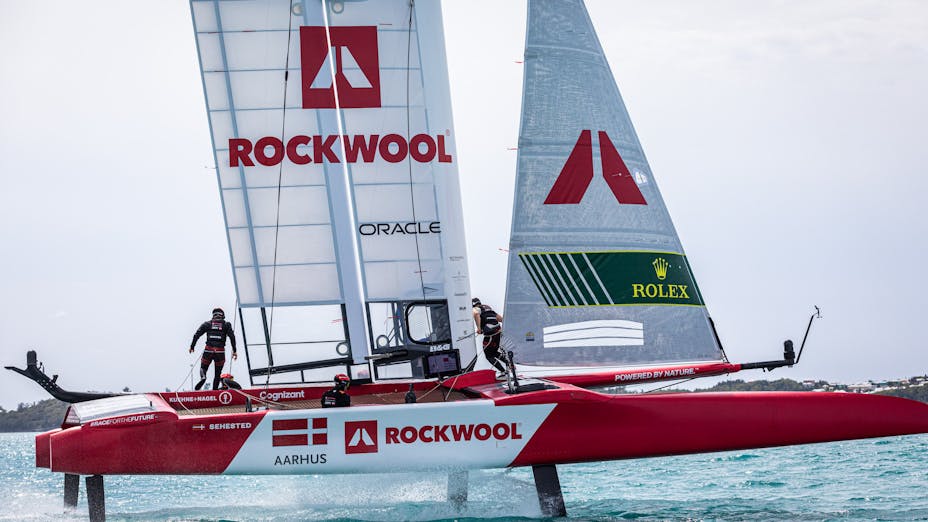
So, what is foiling, how does it work, and when did sailing become so… cool?

It's all about drag

The story behind hydrofoils
The next frontier.

Beneath The Surface
Watch on youtube.
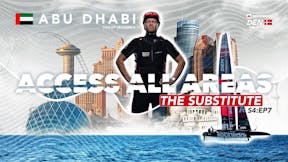
Access All Areas
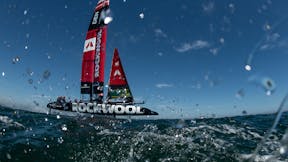
Want to learn more about SailGP?
Meet the denmark sailgp team, find all the latest news, go beneath the surface of sailgp, discover more beneath the surface.
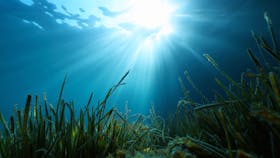
Protecting paradise – Sailing towards a more sustainable future
Like so many coastal communities all over the world, preserving the delicate marine ecosystem and the health of the ocean is of huge priority on the island of Bermuda

Chasing a dream – Risking everything to renovate an abandoned hotel
When builder Bryan Baeumler stumbled upon a decaying and abandoned resort on the tropical island of St. Andros in the Bahamas, he was compelled to quit his cosy life in Canada and transform the ruin into a luxury escape. His top priority when revitalising the dilapidated resort was to renovate in the most sustainable way possible, with true respect for its island location. But how could this be done?

The Beneath The Surface show
We go Beneath The Surface of SailGP's iconic host cities, set a spotlight on great projects and curious mind and catch all the lastest with the Denmark SailGP Team. Join us as we travel the world and explore how innovation and science is helping solve the world's biggest challenges!
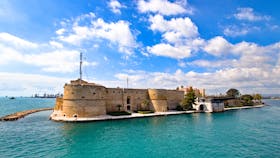
Helping Taranto sail towards a brighter horizon
Taranto, and other parts of the southern region, has long suffered from brain drain. But can the renovation wave that is currently sailing through Italy help reverse this trend and breathe new life into this once charming city?

ROCKWOOL Group
- Yachting World
- Digital Edition

Fastest sailboats: The teams aiming to break 80 knots
- April 6, 2022
It's been nearly a decade since Sailrocket set a new record to become the world's fastest sailboat. Now two teams are hoping to set a new record with their radical designs, Mark Chisnell reports
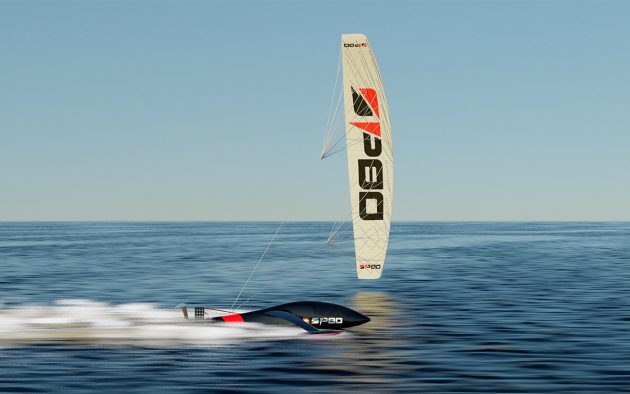
On 24 November 2012, Paul Larsen and his Sailrocket team rewrote our understanding of the physics of sailboats, stamping their names indelibly in the record books as they set a new record for the world’s fastest sailboat.
A little over a week earlier, at a spot called Walvis Bay on the coast of Namibia, Sailrocket 2 had pushed the outright sailing speed record up by the biggest-ever margin – from 55.65 to 59.23 knots. The performance on the 24th smashed it beyond all expectations though, a gloriously windy day that saw Sailrocket 2 deliver a 65.45 knot average officially becoming the world’s fastest sailboat.
It was a remarkable human achievement, piloting a boat down a 500m course at speeds that had previously been thought impossible. “Your job is to go 100% down that course, there’s no halfway about it,” Paul Larsen told me, almost a decade later. “By the time you’ve got a big team and all the momentum of that project going, your biggest fear is not going fast.”
The risks are inescapable though, as Larsen had revealed in a blog; “As I lay awake in bed that morning I considered writing a little note that I hoped would never be read and stashing it somewhere. Too morbid. Just get it right, Larsen.”
Growth of the world’s fastest sailboat
To put Sailrocket’s performance into context you need to consider the trajectory and history of the sailing speed record . It started back in 1972 with Tim Colman and Crossbow setting an opening mark of 26.30 knots.

Yellow Pages in 1993. Photo: Frederick Clement/DPPI Media/Alamy
By 1993, Yellow Pages had upped that all the way to 46.52 knots – an average improvement of almost a knot every year. But then something changes, progress halts for over a decade. The windsurfers and kiteboarders eventually start nudging it back up, but it’s 16 years before another yacht – Alain Thebault’s foil-borne L’Hydroptère – sets a new record, not even five knots quicker than Yellow Pages .
It was thought that the speed of sailing machines was reaching a ceiling, a physical limit defined by the cavitation point. If you have ever made a cup of tea at altitude then you will know that the boiling point (the transformation point where water changes from a liquid into a vapour), varies with pressure. The lower the pressure, the lower the temperature required for water to boil. So, at the top of Everest, water will boil at about 68°C.
There’s also low pressure on the leeward side of an aero- or hydrofoil . Foils provide a lifting force because of the pressure difference between one side and the other. This difference creates the force as the foil tries to equalise the pressure.

L’Hydroptère claimed the record in 2009. Photo: Christophe Launay
If a hydrofoil goes fast enough then the pressure to leeward will drop sufficiently that the water starts to ‘boil’ or vaporise. This creates a loss of lift, and instability as smooth flow turns chaotic, with vapour bubbles flowing down the foil to an area of higher pressure where they collapse.
It’s this speed limit that we see America’s Cup and SailGP foilers hit on a reach. Once the speed gets much above 50 knots the foils – which are designed to suppress cavitation for as long as possible – finally start to cavitate and the boats just can’t go any faster.
To get past this point a completely different type of foil is required, one that does not try to eliminate cavitation but instead tries to stabilise it, and this is the secret to the 65-knot speed of Sailrocket 2 . “That’s the brilliant [foil] design that we settled on, with a lot of help from guys like Aerotrope and Chris Hornzee-Jones. Chris did amazing work behind the scenes on that project, including designing the final foils,” said Larsen.
Article continues below…

Syroco: Radical design aiming to set a new speed record
If having a top-flight speed sailor as a part of your team taking on the challenge of creating the world’s…
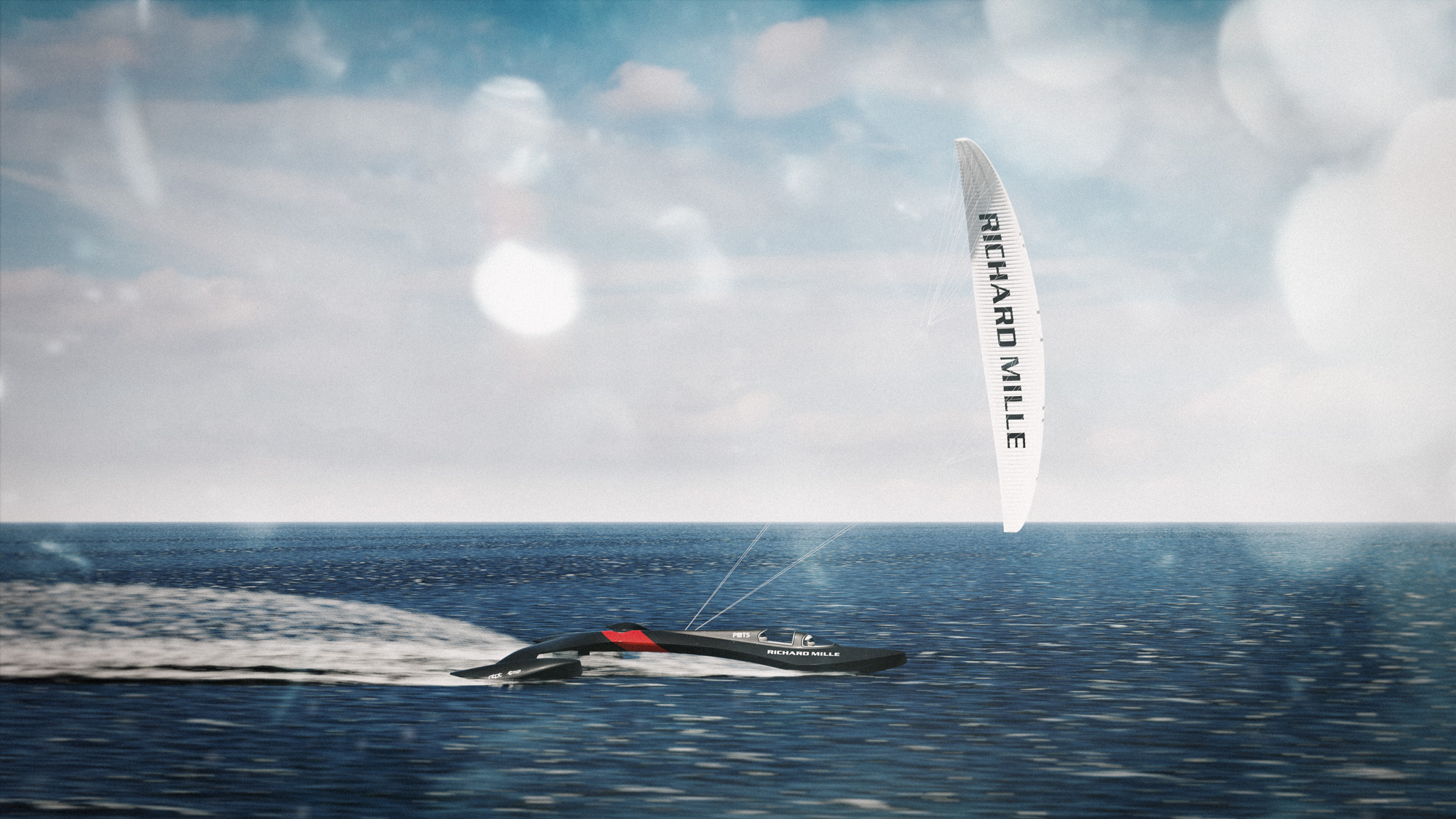
SP80: Swiss team hoping to build the fastest sailboat
SP80 was conceived by three graduates of Swiss engineering school, École Polytechnique Fédérale de Lausanne; Benoît Gaudiot, Xavier Lepercq and…

Sailrocket obliterates world record….again
Matthew Sheahan talks to Paul Larsen shortly after he exceeds 65 knots, shattering his own world record
The team realised the foil didn’t need to be impossibly thin to suppress and avoid cavitation. Instead, they could encourage it and push past the cavitation point with a foil that would cavitate in a stable fashion.
“To make a dinghy or a powerboat analogy, it’s like when you get over that hump and the boat gets up on the plane. We all know when the water separates off the back of the boat, you don’t want your transom gurgling around at the back there with all that drag,” Larsen explains.

Current speed record holders Paul Larsen and Vestas Sailrocket 2. Photo: Vestas SailRocket
In a similar fashion, Sailrocket 2 ’s foil is able to shed the turbulent, draggy flow of early cavitation and replace it with a single smooth pocket of vapour around the foil as air sucks down from the surface. Larsen calls this a base ventilated foil, it’s also sometimes termed a super-ventilating foil.
“So you end up with these very shallow camber, base ventilated foils, and they’re not overly efficient but they don’t have a limit,” he explained. “They keep working. It’s like a jet fighter’s wings. They’re not efficient, but if you put a big jet engine behind them, they keep going where the others stop and hit the ceiling.”
Force alignment
The jet engine was the other part of the problem. How do you generate enough power from the aerofoil to push a horribly inefficient hydrofoil up to the speeds required to start cavitation, and then blow through that barrier?
The answer lay in a decades-old idea – force alignment. In conventional sailboats, be they dinghies, multihulls or yachts, the aerodynamic force created by the sails is both pushing the boat forward and pushing it over.
The force is resisted by a combination of a hydrodynamic force from a foil in the water, and weight – either the crew’s bodyweight or the weight of a keel. These two forces act at a distance from the centre of effort of the sail – creating opposing levers, with the forces of mass and hydrodynamic lift opposing the aerodynamic force generated by the sail (or wingsail).
The use of these forces to create a propulsive forward force demands a structure of a commensurate size and strength. So to go faster required more force and/or lighter overall weight, but also stronger structures. It was big improvements in the strength and weight characteristics of materials that allowed much of the jumps in speeds set through the 1970s, 80s and 90s.

Vestas Sailrocket 2 used force alignment to achieve her remarkable speeds
But there was another way: by offsetting the forces and aligning them. “So [you] have the centre of effort of the aerodynamic forces, the sail or the wing, directly aligned with the opposing force of the foil,” explains Larsen. In other words, remove the levers by having the force from the sail directly oppose the force from the hydrofoil.
“We didn’t come up with that concept, that was written about in the 1960s by Bernard Smith in the book The 40-Knot Sailboat ,” Larsen adds. Smith’s insights were so far ahead of his time that it took almost five decades for them to be fully realised in Sailrocket 2’s record.
Sailrocket 2 achieved the force alignment with a wing mounted on the leeward hull that was canted over the windward hull by 30°. The force it generated was driving the boat forward and trying to lift the windward hull out of the water.
This force was resisted by a foil under the windward hull. And so that foil was pulling down rather than pushing up. It’s a crucial distinction between Sailrocket 2 and the type of foiling craft used in the America’s Cup or SailGP. In those boats, it’s the leeward hydrofoil that pushes back against the sail force. It also lifts the whole boat up and out of the water.
These two breakthrough ideas – force alignment and super-ventilated foils – along with a ‘no guts, no glory’ attitude, took Larsen and his Sailrocket 2 team over 65 knots, a mark that has been held for almost a decade. But might the time have come for that record to be broken?
“I think we’ve sat on it for long enough and it’s definitely time for it to be challenged,” Larsen says. “There was a time I was quite protective and proud of it, and wanted to sit on that throne for a while. But right now I want to see what other people can do with it and see what their solutions might be. I’ll see if it motivates me enough to get back out there myself!”
New fastest sailboat challengers
There are two major challenges shaping up to take on the Sailrocket team’s record and both should take to the water later this year or early in 2023. One of them, Syroco , has been set up by Alex Caizergues, the first man to travel sail-powered at over 100km/h on water, and twice holder of the outright sailing speed record on his kiteboard. The other, SP80 , has come out of the Swiss engineering school École Polytechnique Fédérale de Lausanne (EPFL).

Kite-powered SP80 challenge uses a super-ventilating surface piercing foil. Photo: SP80
Both are using the principles that Larsen established, and both teams think they won’t just break the record but will smash it. Syroco ’s stated target is 150km/h, a breathtaking 80.99 knots. SP80 is also chasing the 80-knot barrier.
“I actually like where both projects are aiming,” said Larsen. “They’re definitely using the force alignment concept.” Both the SP80 and Syroco teams will use a kite, aligning its aerodynamic force with the hydrodynamic force from a foil. This should allow the generation of an immense drive force on a relatively light structure. They will need all the power they can get to push through the cavitation point.
The SP80 project is also using a super-ventilating, surface piercing foil like Sailrocket’s. “Vestas Sailrocket and the work done by Paul Larsen and his team was the main source of inspiration that we used to develop the boat,” said Benoît Gaudiot, one of the three founders of SP80 .
They started throwing around ideas in 2017, building super-ventilated fins for a kiteboard. Gaudiot, an experience kitespeed sailor quickly got it to 41 knots. They were going to need a different approach to beat the record though.
“The body cannot handle the power that is required to reach more than 60 knots,” said Gaudiot.

SP80 co-founders Xavier Lepercq, Mayeul van den Broek and Benoît Gaudiot. Photo: SP80
Another of the founders, Xavier Lepercq, built a simulation tool, and they started developing designs. What they came up with was a trimaran powered by a kite, whose aligned force was balanced by a surface-piercing foil.
Once this was formulated the team quickly grew, with EPFL pledging its support and sponsors coming on board. “In the team, we have six full-time employees and almost 40 students from EPFL,” explained Mayeul van den Broek, the team’s project manager. They tested a prototype on Lake Geneva in 2020 and in June 2021 began construction of the full-size craft at Persico Marine.
The transition to a kite means that the biggest challenge to both teams is control – accurately balancing the aero and hydrodynamic forces. SP80 has tackled it with what they call the ‘power module’. “The idea behind this is to balance the force. The way we designed the boat, the main thing to achieve was stability,” said Gaudiot.
The exact mechanism of the power module is confidential, but it’s visible at the back of the boat in their visualisations and animations. It provides a direct link between the kite and the hydrofoil and appears to ‘trim’ the hydrofoil depending on the force vector coming from the kite. The shape of the foil and the linkage to the power module are key to the flight stability of the craft.

Swiss SP80 team has been testing its prototype on Lake Geneva. Photo: SP80
“It’s fully mechanical and it’s fully adjusting the balance by itself,” said Gaudiot. “The controls will be quite simple for the pilot. There will be no need for me to control the height, the elevation of the boat, just the direction. And the power of the kite.” The kite lines will run to the cockpit and be controlled with the hands, while the direction of the boat will be controlled with the feet.
The SP80 team plan to challenge the record from a base in the south of France early in 2023, and Paul Larsen is looking forward to it. “I think the SP80 is a more practical solution that has made compromises for practicality. And I think I can get my head around that one a bit more. I think SP80 is probably closer to getting results. And I want to see how a kite’s going to go against the [Sailrocket] wing, because historically wings are faster.”
Flight on water
Looking to spoil the Swiss party is Syroco , a French company that comes to the world sailing speed record with gold-plated credentials. Co-founder and CEO Alex Caizergues has already held the record on his kiteboard.
“Since Paul broke the sailing speed record, I knew that we had to change the software and the way to go fast on water. I knew that I had to assemble around me a team of people able to build this kind of craft,” Caizergues recalls.
Caizergues isn’t just an athlete, he’s a business school graduate with an entrepreneurial track record. Syroco was set up in 2019 with four co-founders and support from technology entrepreneurs and venture capitalists.

Artist’s rendering of how the Syroco craft will look in action. Photo: Syroco
They want to do more than just break the record, building a technology business around the attempt. The team has about 15 people working in Marseille with specialists in fluid mechanics, structures, software and data analytics.
“Our l’aile d’eau concept… it’s a little bit like Sailrocket,” said Caizergues. The concept is very simple; a hydrofoil will ‘fly’ underwater, pulled along by a cable that’s connected to a kite flying in the air above it.
Suspended between the two is a capsule containing the pilot Alex Caizergues, and a co-pilot. The aero and hydrodynamic forces oppose each other in an almost perfect representation of the aligned forces concept that powered Sailrocket 2 .
It should have the greatest speed potential because there is nothing extraneous. The capsule is only there because both the aero and hydrodynamic wings must be controlled, and the forces balanced by the pilots (not automated).

The Syroco prototype under test being towed by a RIB. Photo: Syroco
And that’s the tough part, controlling it, particularly keeping the foil in the water. “Nope,” responds Alex, quickly, when I mention this possibility. “The foil never goes out of the water.” The Syroco foil isn’t surface piercing, it runs below the surface, only connected to the capsule and the kite by a cable.
It doesn’t rely on dragging air from the surface to stabilise the cavitation around the foil. Instead, it will rely on the cavitation creating its own stable pocket of water vapour around the foil – this is called super-cavitation. When it occurs the water flows around the bubble of vapour as though it were a solid, significantly enhancing the performance of the foil – as long as the bubble remains stable.
The problem is keeping the bubble intact. Paul Larsen pointed out that the cable gives the air a pathway down to the super-cavitating foil. “How they’re going to stop air sucking down from the surface and rupturing the bubble, that’s the real trick. It’s a very dynamic problem to solve. It’ll be interesting to see how well their simulations live up to the reality of what they’re about to strap themselves into…”
The control mechanisms for the final craft are still being worked on, but they have flown a prototype, towed by a RIB rigged with a 5m-high mast that simulated the force from the kite. The team hopes to commit to a final design with construction starting in the spring.
Human element
And then of course, there will be the matter of executing the plan on the day. “If you’ve done your maths, you’ve done your engineering, you’ve been thorough, that gives you confidence when you stand up on top of that course on one of those big days and you’re not exactly sure what’s about to happen,” recalls Larsen.

Kiteboarder and businessman Alex Caizergues leads the Syroco project. Photo: Syroco
“You know it’s probably just slightly above your top wind range but all the cameras are rolling and the drones are in the air and everyone’s waiting with their stopwatches. That gives you the confidence to say: ‘Yeah, I’m going to go and wring its neck.’”
“Any crashes I had [and there were several] usually all the systems I had in place [for safety] were still completely locked on among all the wreckage. You’d go and flick off that lever you were going to use to control something – because by the time you’ve realised what’s happening, it’s happened.”
“If we go again with Sailrocket, then safety will feature bigger. I wouldn’t get in that boat and go that speed again. We got away with it because we had to.”
“Safety is really important for us,” agrees Benoît Gaudiot. They have built a kevlar cockpit for protection, installed a six-point harness and an F1-inspired seat. Gaudiot will wear a helmet with oxygen that will switch on if the helmet detects water in contact with its mask. “I would be able to stay in the water for a few minutes to have a diver come and open it.”
“The critical point on the boat is the hydrofoil. If the hydrofoil breaks, the boat…” Van den Broek interjects. “…will take off,” Gaudiot finishes the sentence for him.
Their enthusiasm for the project is infectious, the words tumbling out. And no one wants the boat to take off. One big advantage that they have that Larsen did not, is that they can release the power source. “With a kite it’s a few lines and you can just cut it super-fast,” says Gaudiot. “You can do it by yourself. You can do it from a distance, from the chase boat. You can do it automatically.”
“I think both those guys [Caizergues and Gaudiot], they’ve got the mentality,” said Larsen. “They’re not going to get up there and be scared of what they’re doing or intimidated too much by the craft.”
And what if they do break the record that Paul Larsen and his team have owned for almost a decade?
“We opened the door on a whole new world full of potential. And so there is a part of me that’s curious as to what lies further down that path. We validated the concepts that could get above what people thought were the cavitation limits and the ceilings of speed sailing. We proved you could get beyond that. They can take you to new levels of physics.
“The boat [ Sailrocket 2 ] is sitting there in perfect shape. It was made to last forever… we could rig that thing up and do 65 knots in a week or two.” And if his record goes, I wouldn’t put it past him to dust her off and do just that.
If you enjoyed this….
Yachting World is the world’s leading magazine for bluewater cruisers and offshore sailors. Every month we have inspirational adventures and practical features to help you realise your sailing dreams. Build your knowledge with a subscription delivered to your door. See our latest offers and save at least 30% off the cover price.

- Find A School
- Certifications
- North U Sail Trim
- Inside Sailing with Peter Isler
- Docking Made Easy
- Study Quizzes
- Bite-sized Lessons
- Fun Quizzes
- Sailing Challenge
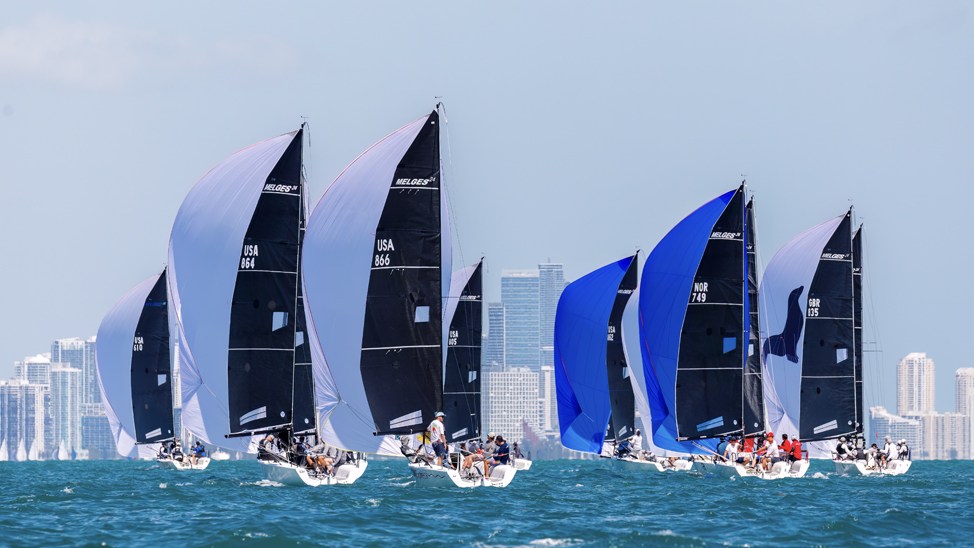
Mastering Sailboat Racing Tactics: A Winning Approach
By: Zeke Quezada, ASA Sailing Races
Sailboat racing demands a unique blend of skills and expertise. The dynamic nature of racing, with its ever-changing winds and currents, requires sailors to excel in various aspects to secure victory. One of the biggest challenges is dealing with the fluid playing field upon which we play. At North U, experts understand that sailboat racing success is built on a pyramid comprising Boat Handling, Boat Speed, and Tactics, with Tactics reigning supreme at the pinnacle.
Building the Foundation: Boat Handling and Boat Speed
Before delving into the intricacies of racing tactics, it’s crucial to lay a solid foundation. Boat Handling forms the base of the pyramid, emphasizing the importance of mastering the art of sailing. Without proficient boat handling skills, even the best tactics would falter. Next in line is Boat Speed, a universal requirement across all forms of racing. Whether it’s bicycles, bobsleds, or sailboats, speed is the essence of victory in any race.

Reaching the Summit: Racing Tactics
Atop the Racing Pyramid stands Tactics, the ultimate decider in the world of sailboat racing. Once you’ve honed your boat handling and achieved exceptional speed, mastering tactics becomes the key to clinching victories. Tactics, in its broadest sense, encompasses Strategy and Tactical execution, each playing a pivotal role in the race.
Understanding Strategy and Tactics
Strategy is the overarching plan that revolves around wind, wind shifts, and current. It is an overall gameplan detailing how a sailor would navigate the course independently while factoring in the complex interplay of natural elements. On the other hand, Tactics involve the practical implementation of the strategy and the adept handling of other boats in the race. Understanding and adhering to Racing Rules are part of Tactics, as the rules dictate your rights and obligations as you deal with other boats.
General Tactical Tips:
- Craft a Comprehensive Strategy: Formulate a game plan based on your expectations of the wind’s behavior. A well-thought-out strategy provides a roadmap for your race.
- Get a Good Start: While a perfect start is ideal, it’s not mandatory for victory. Focus on launching at full speed from the starting line, ensuring you have clear air near the favored end. A strong start sets the tone for the race.
- Chase the Wind: Seek out areas with more wind and navigate your boat towards these pockets. Sailing in favorable wind conditions gives you a significant advantage over competitors.
- Embrace Speed: Sailing at maximum speed is a game-changer. Position your boat in a way that allows you to maintain top speed throughout the race. Sometimes, the simplest strategy is the most effective.
- Master the Shifts: Tacking and jibing strategically based on wind shifts is crucial. Upwind, tack when you’re headed away from the mark and sail on the lifts that push you towards it. Downwind, jibe when lifted away from the mark and sail on the headers, guiding you in the right direction.
Sailboat racing tactics are the culmination of strategic planning, meticulous execution, and adaptability to the ever-changing elements. By mastering the art of strategy and tactical maneuvers, sailors can elevate their racing performance.
Ready to Become a Master?
Choose from among American Sailing’s many resources to help you improve your racing — from online courses, to textbooks, to week-long events, you can choose one or all to upgrade your sailing racing skills.
Online Classes
Learn more about how to form winning racing strategies at the Racing Strategy, Tactics and Rules Online Class. This 4-session series hosted by Bill Gladstone starts October 17, 2023.

The most complete books on modern racing tactics and trim, North U takes you all the way around the course. These textbooks are an essential part of any racing sailors library.

Performance Race Week
At American Sailing Performance Race Weeks powered by North U, we spend five days exploring every facet of racing success through an enriching blend of practical on-water training and races complemented by shoreside seminars and insightful video reviews. With a coach on every boat, you’ll receive close personal attention to build on your strengths and eliminate your weaknesses. Join us for this unique opportunity to become a better, more versatile, and more accomplished sailor.

Related Posts:

- Learn To Sail
- Mobile Apps
- Online Courses
- Upcoming Courses
- Sailor Resources
- ASA Log Book
- Bite Sized Lessons
- Knots Made Easy
- Catamaran Challenge
- Sailing Vacations
- Sailing Cruises
- Charter Resources
- International Proficiency Certificate
- Find A Charter
- All Articles
- Sailing Tips
- Sailing Terms
- Destinations
- Environmental
- Initiatives
- Instructor Resources
- Become An Instructor
- Become An ASA School
- Member / Instructor Login
- Affiliate Login
- New Sailboats
- Sailboats 21-30ft
- Sailboats 31-35ft
- Sailboats 36-40ft
- Sailboats Over 40ft
- Sailboats Under 21feet
- used_sailboats
- Apps and Computer Programs
- Communications
- Fishfinders
- Handheld Electronics
- Plotters MFDS Rradar
- Wind, Speed & Depth Instruments
- Anchoring Mooring
- Running Rigging
- Sails Canvas
- Standing Rigging
- Diesel Engines
- Off Grid Energy
- Cleaning Waxing
- DIY Projects
- Repair, Tools & Materials
- Spare Parts
- Tools & Gadgets
- Cabin Comfort
- Ventilation
- Footwear Apparel
- Foul Weather Gear
- Mailport & PS Advisor
- Inside Practical Sailor Blog
- Activate My Web Access
- Reset Password
- Customer Service

- Free Newsletter

Ericson 41 Used Boat Review

Mason 33 Used Boat Review

Beneteau 311, Catalina 310 and Hunter 326 Used Boat Comparison

Maine Cat 41 Used Boat Review

Tips From A First “Sail” on the ICW

Tillerpilot Tips and Safety Cautions

Best Crimpers and Strippers for Fixing Marine Electrical Connectors

Thinking Through a Solar Power Installation

Getting the Most Out of Older Sails

How (Not) to Tie Your Boat to a Dock

Stopping Mainsheet Twist

Working with High-Tech Ropes

Fuel Lift Pump: Easy DIY Diesel Fuel System Diagnostic and Repair

Ensuring Safe Shorepower

Sinking? Check Your Stuffing Box

The Rain Catcher’s Guide

Boat Repairs for the Technically Illiterate

Boat Maintenance for the Technically Illiterate: Part 1

Whats the Best Way to Restore Clear Plastic Windows?

Mastering Precision Drilling: How to Use Drill Guides

Giving Bugs the Big Goodbye

Galley Gadgets for the Cruising Sailor

Those Extras you Don’t Need But Love to Have

UV Clothing: Is It Worth the Hype?

Preparing Yourself for Solo Sailing

How to Select Crew for a Passage or Delivery

Preparing A Boat to Sail Solo

On Watch: This 60-Year-Old Hinckley Pilot 35 is Also a Working…

On Watch: America’s Cup

On Watch: All Eyes on Europe Sail Racing

Dear Readers

Chafe Protection for Dock Lines
- Marine Electronics
- Systems & Propulsion
- Boat Maintenance
Portable Sailing Tools for Tracking and Tuning Boat Speed
Practical sailor tests the speedwatch and two souped-up gps devices from velocitek..
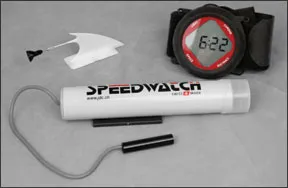
The marine GPS receiver in its purest form is meant to answer three important questions: Where are we? What direction are we going? How fast we are going? For the philosophical navigator, the answers to the first two questions may be the most intriguing, but for the Melges 24 racer bound for the finish or the Caribbean cruiser hoping to drop anchor before sundown, the digits beside the word “knots” are much more compelling. So it should come as no surprise that a new breed of GPS devices-appealing directly to our need for speed-are making steady inroads into the sailing market.

Although the racing rules for many sailboat classes ban the use of portable GPS devices during racing they are popular training tools, and many local fleets make exceptions to allow the use of GPS. Compact, watertight, and wireless, battery-powered GPS units are particularly useful on smaller boats.
The earliest GPSs were poor tools for tracking speed. Fixes were deliberately imprecise (for the sake of national security) and they erratically averaged speed by using the distance/time formula and a breadcrumb-trail of trackpoints. By comparison, a modern GPS receivers has very precise fixes and can almost instantaneously calculate speed by monitoring the frequency shifts (Doppler shift) of the satellite signals it tracks. Just as a train whistles rising pitch can be used to calculate how fast a train is approaching the station, the frequency change in signals from GPS satellites can be used to determine how fast a boat is going. Advanced GPS chipsets in two devices reviewed for this article can calculate speed and heading solutions four times per second. This often yields results that are more accurate than can be displayed by typical sailing instruments, since these are usually limited to resolutions of 0.1 knot and 1 degree.
As any navigator knows, GPS devices calculate speed over ground (SOG) and course over ground (COG), not speed through the water, which requires a knot log to measure. Although sensors that accurately measure speed through the water, wind direction, and wind speed are standard for high-level racing, speed over ground and course over ground is sufficient for many racers. Among other things, SOG and COG can help define optimum points of sail, refine sail or hull trim, reduce skin drag or leeway, and judge the best time to tack. Combined with a magnetic compass, COG and SOG can also help quantify the effects of a cross current.
And, as we found with two of the devices tested for this article, with the right firmware and software, this GPS-based data can be displayed, logged, and later reviewed in ways that makes it useful to sailors of all levels.
What We Tested
Practical Sailor testers recently spent a week experimenting with three handheld products geared toward performance sailors. Unlike conventional portable GPS units, which have relatively small displays and deliver a wide range of navigational data, these products display relatively large digits that can be read from a distance, and the view options are limited to those that relate exclusively to speed and racing performance. Latitude and longitude are nowhere to be found until you download the data for review on a computer. In addition, the rate at which data is updated in these devices is faster than youll find in many multi-purpose GPS devices.
Two of the devices we reviewed, the SC-1 and the SpeedPuck, are made by Velocitek, a company founded by surfer and windsurfer Alec Stewart, who left Stanford Engineerings Aeronautics and Astronautics PhD program to start the business. Both devices use GPS satellite signals to monitor speed and performance. The third product, the Speedwatch, has no GPS receiver, relying instead on a tiny propeller mounted on the hull to record actual speed through the water. The data is then delivered wirelessly to a wristwatch display.
Testers also experimented for a few hours with SailClever, a relatively new smart-phone application that can be wirelessly linked (using Bluetooth) to a GPS receiver and other onboard instruments to serve as a handheld tactical computer. The product, which was still in testing at the time of this article, is reviewed separately on page 30. PS did not get the chance to evaluate the Rockbox AMPD ( www.rockcitymarine.com ) and the Nauteek ( www.nauteek.com ), two products that perform similar functions as the Velocitek SC-1. PS plans to review these products in a future article.

How We Tested
The products were evaluated based on three chief criteria-ease of installation, performance on the water, and durability. Because the SpeedPuck and SC-1 also allow racers to download data for evaluation on a computer (Windows), testers also rated them on this function.
For the installation review, testers installed the units on a 1974 ODay Javelin, an Uffa Fox design and an early ancestor of todays planing skiffs. The on-the-water evaluations took place over the course of six days, and the units were first tested independently and then together while sailing on the Javelin. Sailing speeds ranged from 1 to 9 knots. High-speed testing on a powerboat ranged between 15 and 30 knots.
Screen visibility was compared in bright sunlight, both with and without sunglasses, and at night. For battery testing, any automatic shut-off features were disabled and the units were left on until the battery signal indicated an empty battery. For the durability testing, the display components went through our usual routine for handheld electronics: Put in the oven to 140 degrees for 30 minutes, placed in a freezer at 15 degrees for four hours, subjected to five minutes of direct jet spray (approximately 45 pounds per square inch) from a garden hose, submerged 3 feet underwater for 30 minutes, and dropped on each side on a fiberglass deck from 3 feet height. All of the units passed the durability tests with flying colors. Comparison data and test results in the other areas appear on the chart on page 28.
Developed by JDC Electronics in Switzerland and distributed in the U.S. by Ocean Equipment, the Speedwatch comprises three components: A tiny propeller that mounts on the bottom of the hull in a place of clean water flow, a transmitter that needs to be mounted above the water and 12 inches from the propeller, and the watch-like display that can be worn on the wrist or leg, or mounted on the boat.
The transmitter (powered by a 9-volt battery) picks up magnetic pulses from the rotating propeller and wirelessly delivers the data to the display, where it is processed and displayed. The watch (powered by a long-life lithium battery) must be no more than 13 feet away from the small transmitter, not a problem on most small boats.
One neat feature is that the system requires no wires or holes in the boat. Testers used the removable fin (photo below) mount, which easily slides onto a small permanent mount. (Three locations were tried.) Two other mounting options are provided, and all make it fairly easy to remove the propeller when its not in use.
Anyone familiar with a digital watch can use the nine-page manual and figure out the four buttons that select the display modes. Surprisingly, this was the only device tested that had a backlight for use at night, although testers had to view the screen at an angle when using the light. Speed is displayed one of four ways: instantaneous speed, balanced speed, and the maximum and average speeds over a timed run. The balanced speed is essentially a damping feature, displaying the average speed during a user-defined interval, between 2 and 60 seconds. It also functions as a watch, stopwatch, and countdown timer with audible signals for race starts.
Unlike the other two devices tested on the water, this is the only one designed to deliver speed through the water. This ability would be very useful for getting instantaneous readouts to help gauge the effects of weight placement or sail trim. Comparing this speed data with speed over ground from GPS, you would also be able to gauge the effects of current.
However, at speeds of less than 6 knots, readings were inconsistent, at times registering less than 2 knots when the boat was clearly moving much faster (confirmed by GPS). Tests at higher speeds on the powerboat showed more consistent readings.
Bottom line: This Speed Watch is compact, easy to install and use, and its battery life far exceeds that of the two GPS-based products. However, testers concluded that the device, with several potential failure points, offered little advantage over the GPS-based devices to the average sailor.
Velocitek SC-1
Predecessor to the SpeedPuck, the Velocitek SC-1 includes the same speed and heading functions found in the SpeedPuck and adds several other functions, including velocity made good (VMG), a “tactical compass,” start timer, distance to line, and the ability to display two functions at once.

Enclosed in a rugged, watertight box with two latches, the SC-1 is heavier and bulkier than the SpeedPuck and has four buttons. These watertight capacitive touch sensors, designed to stand up to the extreme forces of a 25-plus-knot capsize, introduce unnecessary complications for the less-than-10-knot crowd. (When you have to read the manual to figure out how to turn something on and off, something is amiss.) Because the buttons can be activated by splashing water, they are programmed to lock after periods of inactivity or when a minimum speed is reached.
Briefly tempted to subject the SC-1 to more rigorous impact-resistance tests, testers instead disabled the auto-lock feature (via the Control Center software with a computer).
Once you master the button controls , the SC-1 can be put to good use on the race course. Both the tactical compass heading and the VMG functions are based on a reference wind direction that is manually programmed into the SC-1. Once the referenced wind is set, the tactical compass mode displays what is effectively the relative wind angle, while the VMG function indicates the boat speed upwind or downwind.
The distance-to-line function requires the sailor to enter marks as close as possible to the committee boat and pin-ends of the start line. Once these points are entered, the display will indicate the perpendicular distance to the start line from your boat. The distance is accurate to between .75 and 3 meters, depending on the number and location of the satellites in view at the time.
As with the SpeedPuck, the race data can be downloaded and evaluated using Speed Play or the bundled GPS Action Replay.
Bottom Line: Plan to spend some time with the manual to make the most of this unit. The more advanced racer will appreciate the VMG and distance-to-line functions, but don’t expect your crew to master the button-pushing basics without some initial cursing under their breath.
The SpeedPuck could be considered a light version of Velociteks SC-1, delivering only the most essential data to sailors who refuse to touch an owners manual. It uses the same 16-channel GPS chipset (U-blox Antaris LEA-4A) as the SC-1, but it displays only three key pieces of data: Speed (maximum or maximum 10-second average), heading, and windshifts. Round, with a screw-on back sealed with an 0-ring, the SpeedPuck is well engineered to withstand abuse. Its display is easier to read than the SC-1, and its single button is much simpler to use than the Velociteks recalcitrant touch sensors. It also has a blank-screen log mode that simply records data for later replay, useful in races that prohibit GPS aids.
Installation is fast and easy. Just stick the adhesive-backed 3M Dual Lock hook-and-loop mounting pad wherever you want to put the device. Other mounts are available. The SpeedPuck also has a wrist lanyard, but it is too big to be considered a pocket instrument.
One of the SpeedPucks key features is the way it presents heading data. As soon as you hold a compass heading for 20 seconds, it locks on that course and a single bar appears on the display, centered at the 12 oclock position. Any significant variation from that heading is indicated by additional bars to the left or right of the 12 oclock position on the puck; each bar represents three compass degrees.

While sailing, this display offers instant feedback on slight course changes, which can also help detect wind shifts. Two bars to the right (clockwise) from 12 oclock, for example, means the boat is heading 6 degrees to starboard of its original course. If it is on port tack at the time, and the tell tales are still streaming nicely, then the boat is getting headed. If we hold this new course for 20 seconds, the SpeedPuck resets, again showing a single bar at 12 oclock. This delay would be a problem when racing, but for tweaking trim and basic training, the system works well, and is easier to use than simple compass bearings.
The SpeedPuck was the testers favorite on the water. It was dead simple to set up and easy to use. A couple of times as the test boat ghosted in very light winds, the heading indicator bar disappeared for several seconds. According to the maker, sudden changes of direction or speed can have this effect.
Off the water, the testers used the free downloadable Velocitek Control Center to modify the SpeedPucks default settings. The software lets users specify compass deviation, change the rate of position logging, and alter how frequently speed and heading solutions are updated. A bundled third-party program called GPS Action Replay lets users replay and evaluate logged data, but the track data (a nearly invisible light yellow color at low speeds) is hard to interpret, and the graphics are uninspiring.
Testers also tried Velociteks more user-friendly SpeedPlay software ($49) to review and manipulate the logged data. Once it was installed, the program made it very easy to download recorded data from multiple SpeedPucks or SC-1 units and replay a race. The user can easily drag and drop marks on the plotted routes, and the track can be exported to common formats (KML and GPX) for use with charting software, or mapping tools like Google Earth.
Bottom line: Rugged, easy to install and use, the SpeedPuck is recommended for club racers and small-boat sailors looking for a fun practice tool that monitors speed. Serious racers will long for some of the advanced features of the SC-1, but for quick and easy evaluation of speed over ground, post-race evaluation, and a reasonable price, the SpeedPuck fits the bill.
While there may be a market for the Speedwatch for kiteboarders, windsurfers, and high-speed sailors, based on our testers experience, we don’t recommend it for most sailors. So that leaves us with the Velocitek gear-or the familiar handheld GPS.
If all you need is heading, average speed, and an ego-boosting logged maximum, the basic handheld Garmin GPS units-take the aging 76CSx ($250) for example-will do this and a whole lot more. And virtually all GPSs today let you download and analyze tracks with a range of software.
So, if you need a GPS device anyway, why shell out $250 for the SpeedPuck, or almost twice that for the SC-1? The chief advantages of the Velocitek devices are cleaner designs, bigger readouts, much more rugged housings, faster updates, a dead simple interface, and some fun software to play with after a race. The firmware is designed with sailors in mind, allowing them to easily follow wind shifts, and, with the SC-1, tap into more advanced functions like the tactical compass and distance-to-line. We were also very impressed with the people in tech support, who understand the needs of sailors.
The SpeedPuck, in particular, will make a good training tool for todays young sailors, who-for better or worse -are intrigued by all things digital.
The SpeedPuck and SC-1 will give around-the-buoy sailors the ability to quickly quantify performance without spending a small fortune, but they are no replacement for wind and through-the-water speed sensors.
Ultimately, sailing involves wind and water, and without any true environmental data, the sailor must trust his senses and instincts. It goes without saying that the last two items, which cost nothing but time on the water, are still the sailors most valuable tools.
- Practical Sailor Value Guide: Handheld Performance Tool
- Smart Phone Apps
- View PDF Format
RELATED ARTICLES MORE FROM AUTHOR
Leave a reply cancel reply.
Log in to leave a comment
Latest Videos

What’s the Best Sailboats for Beginners?

Why Does A Sailboat Keel Fall Off?

The Perfect Family Sailboat! Hunter 27-2 – Boat Review

Pettit EZ-Poxy – How to Paint a Boat
Latest sailboat review.

- Privacy Policy
- Do Not Sell My Personal Information
- Online Account Activation
- Privacy Manager

Boating Basics Online is reader-supported. When you buy via our links, we may earn a commission at no cost to you. Learn more
Average Speed of a Sailboat & Factors That Affect Speed
Written by J. Harvey / Fact checked by S. Numbers
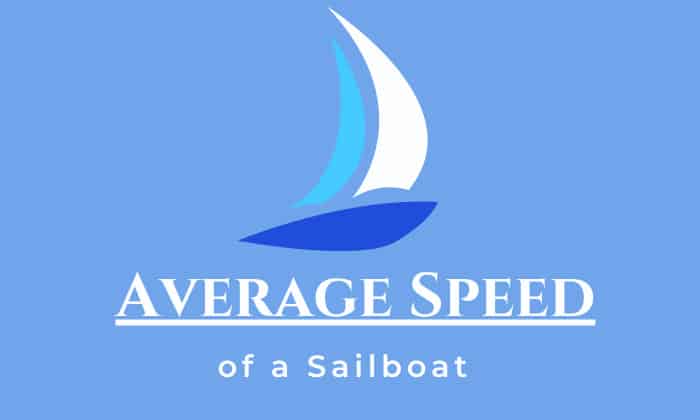
Sailboats have been around for a long time, and even now, when motors are common on vessels, they are still used. But have you ever wondered about the performance and average speed of a sailboat?
A sailboat average speed ranges from 4 to 6 knots or 4.5 to 7 mph and tops out at 8mph . However, many factors affect these estimates, including the type of boat and its hull . Let’s take a closer look.
Table of Contents

Sail Boat Speed
Factors that affect speed, ways to improve sailboat speed, frequently asked questions.
Sailboats have an average speed range of 4 to 6 knots and a sailboat top speed of 7 knots; however, this is an average for all types, and the numbers can change a lot based on the boat model, its hull, along with other factors.
For example, racing sailboats go much faster, up to 20 knots with custom designs reaching up to 50 knots. The fastest sailboat speed on record is 65.45 knots.
Modern ships no longer use sails, but the average sailing ship speed in the 70s was around 4 to 6 knots. This range also applies to the trading galleon that drove much of the world’s commerce in the past.
Averages aside, the fastest sailing ship speed was recorded in 1854 at 22 knots or 41 kph.
- Depending on the sailboat’s dimension
The length of a sailboat directly affects its speed, and longer vessels tend to be faster than shorter ones. The reason is boats need to lift their hull and create speed by riding over the water. This is more easily achieved if the length of the wave is closer to the length of the craft.
Some designs make use of length to boost speeds. Though longer boats tend to be heavy and swift, that doesn’t mean lightweight crafts are slow.
On the contrary, they can be quite fast, but they are vulnerable to strong winds and unstable waters. Multi-hulls are ideal for lighter boats and will be discussed further below.
Here is a table that shows how average speeds differ as length increases. You can see that a 40 ft. sailboat is faster than any smaller vessel, and the fastest small sailboat can not outrun the bigger ones. The exception would be a racing craft.
| Boat Length | Speed in Knots | KPH | MPH |
| 16 feet | 5 | 9.3 | 5.8 |
| 26 feet | 6.8 | 12.6 | 7.8 |
| 36 feet | 8 | 14.8 | 9.2 |
| 40 feet | 8.5 | 15.7 | 9.8 |
| 65 feet | 10.8 | 20 | 12.4 |
- The shape of the boat hull
Hull shape greatly affects the speed and performance of watercraft, with a slim hull and wider transom striking the ideal balance. This shape allows the boat to be faster and more stable .
A hull with a high buttock angle is not able to resist waves and is therefore slower.
- How to measure sailboat speed
To calculate your speed in knots with a calculator, take your vessel’s LWL or length of the waterline from bow to stern in feet. Take the square root of this number and multiply it by 1.34, which is a given figure for the wave crest, related to the wake of your watercraft.
The product is the estimated average speed. In short:
√LWL x 1.34 = average sailboat or average yacht speed knots
Another straightforward method of determining your vessel’s speed is to sail between two points with a known distance in nautical miles. Divide the figure by your travel time to get your average speed in knots.
Conversion from knots to mph or km/h is also useful. One knot is equivalent to 1.15mph or 1.85 kph.
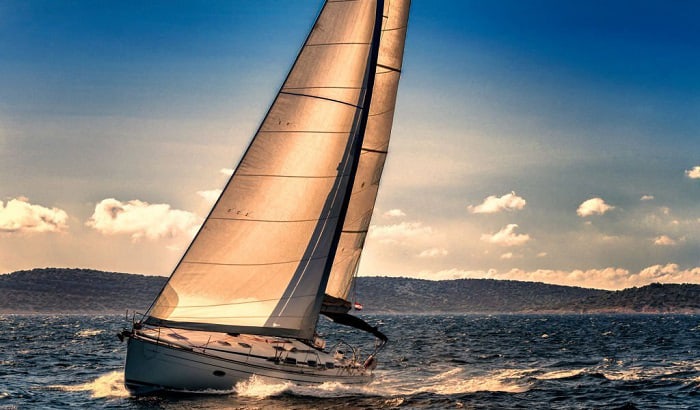
Aside from the boat’s dimensions and shape, hull type, waves, and wind also affect a vessel’s speed.
The two general hull types are the monohull and multihull.
The monohull, also known as the displacement hull, is the standard type used on most boats. These are designed to pierce through the water to reduce drag and can go even faster by lifting the bow.
The multihull is a boat with multiple hulls, as can be derived from the name, and the catamaran is a popular example with its twin hulls. Compared to monohulls of the same size, the average sailing speed of a catamaran and a tri-hull is 9 to 10 knots, which are around 25 to 30% faster compared to a monohull craft.
However, multi-hulls are sensitive to weight imbalances and are less capable of managing heavier loads.
- Water condition
In general, bigger waves tend to accompany higher speeds. That said, waves that are too tall can be dangerous, such as in the case of breaking waves.
Sailboats use a sail, and the wind directly affects their performance. However, the direction is another important factor, since sailing downwind gives a boost in speed, while going upwind will make it difficult to move faster. Being able to utilize the wind effectively can help boost your speed.
You can also take steps to go faster; some are simple to do, but others pose more difficulty.
The first is to ensure that your boat is in good condition, which is already a given. For a sailboat, however, the condition of the sail and mast is a unique and important factor. For instance, the mast should be free of cracks and its extrusions should be secured correctly.
Weight is another important consideration and needs to be managed properly. Aside from minding your cargo weight, it is also essential to balance this weight and distribute it properly.
Proper sailing is another critical point. To reach top speed sailboat needs an operator that employs the correct technique. This includes perfect steering, wind positioning, and sail control; these take time to learn but are essential to reach maximum speed.
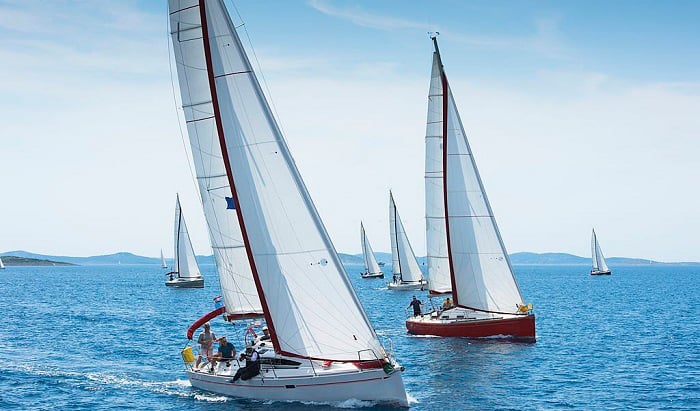
Sailboat speed vs wind speed: can a sailboat sail faster than the wind?
Yes. There are two ways to achieve this, and both involve reducing or eliminating drag between the vessel and the water. One is by lifting the hull using the apparent wind on the sail; the other is by foiling, which brings the boat on top of the water.
How many miles can a sailboat travel in a day?
These vessels have an average sailing distance per day of 185 km, provided that travel is continuous and downwind. If under the power of an engine, the distance traveled increases up to 241 km.
How fast does a sailboat go? Now you know the average speed of a sailboat, along with a better understanding of what affects the numbers and how to improve them.
Sailing crafts are not capable of reaching the same speeds as motorized vessels; however, they offer a very different experience that many boaters find appealing.
How do you feel about sailboats after learning about their speed? Would you try one if given the opportunity? Tell us in the comments section below.
Remember to boat safely.
- The fastest speed of a speed boat.

“My intention from the first day establishing Boating Basics Online is to provide as much help as possible for boaters who want to experience a first safe and convenient trip. So feel free to join us and share your beautiful journeys to the sea!”

Introduction to Sailboat Racing [Rules and Classes Explained]
True, when you first witness a sailboat race, you might believe it’s too confusing and chaotic (it can be both). But, like with anything new, you may ease into it gradually. This is intended to allow you to take several actions at once.
Racing a sailboat is a lot of fun. It blends the excitement of sailing your own boat with the raw rivalry of trying to beat another boat of comparable size. Racing also teaches you boat handling and sail trim in a manner that cruising cannot: by comparing your speed and handling to those of other boats.
Let us jump into the article to learn more about sailboat racing.
![Introduction to Sailboat Racing [Rules and Classes Explained] 1 Sailing boat with two crew members participating in the sailboat racing](https://maritimepage.com/wp-content/uploads/2023/02/Sailboat-Racing-Rules-and-Classes-2-1024x683.webp)
Basic Insights Into Sailboat Racing
Sailboat racing may be separated into three parts: start , headwind , and tailwind . During a sailboat race, it is important to ensure that the beginning of the race must be strong. The start determines the overall outcome of the race and thus is considered very crucial for the race. It brings great advantage to the competitor and this is often very underrated.
As soon as the countdown is complete, it is necessary to make sure that the competitor has crossed the starting line effectively. Generally, warnings are given at 5mins and subsequently at 4mins and 1min .
Another very important aspect to consider is the path . The competitor must be able to determine a clear path to sail through and the direction of the race course must also be perceived correctly to ensure a favorable outcome. Free lanes enable the competitor with ideal angles to the wind with which they can easily navigate without having to go against disturbed wind or wind shadows from rival boats.
![Introduction to Sailboat Racing [Rules and Classes Explained] 2 Sailboat Racing Rules and Classes - Small sailboat racing](https://maritimepage.com/wp-content/uploads/2023/02/Sailboat-Racing-Rules-and-Classes-Small-sailboat-racing-1024x819.webp)
The Starting Line
Oftentimes, the first leg of the race will be upwind, after the starting line is crossed. At this point again, it is important to note that starting strong is crucial for an upwind race as more free lanes are accessible the further ahead the competitor is in the convoy.
The necessary determinants to be noted and kept in consideration throughout the race for effective upwind sailing strategies are the following factors: wind direction, wind speed, and rivals. But the last aspect can be tricky as everyone’s goal is ultimately to win.
Competitors need to base their choices for sailing downwind on the same findings, but with a few minor variations. Being at the forefront and tagged by rivals can be seen as a mode of suffering when the competitor must keep sailing in the wind shadows of all the boats behind. Here, there’s an advantage to be thought of if the competitor can position themselves at the rear. Any lane can be chosen at proper intervals to make up for the lost ground.
However, usually, down winds result in shorter wins and losses than up winds . This is because there is less transverse separation during down winds when compared to up winds.
![Introduction to Sailboat Racing [Rules and Classes Explained] 3 Sailboat Racing of the same class maneuvering near the start line](https://maritimepage.com/wp-content/uploads/2023/02/Sailboat-Racing-Rules-and-Classes-Dinghy-sailboat-racing-1024x683.webp)
Different Types of Sail Racing Classes
Sailboat racing can be done in different ways. Each race lasts for about 45min to 1hr and is conducted on a course marked by buoys mounted by the racing committee. One can also take part in “ distance races “. In this case, the “ natural ” surroundings will typically provide the race course.
The points of sail during the race depend on the predominant wind direction factors on the day of the race, which is the other major variation besides the length. While racing on the course, the race committee places the buoys in such a manner that the race course is adapted to the wind , this mostly enables the competitors to accurately identify which sail has to be deployed for the upcoming leg .
At the race course and during the distance races, the sailboats that participate are usually of various types and are commonly very diverse. As a result, the organizing committee frequently employs intricate “ handicap ” mechanisms to even out variations across boat types . The system is often country-based and it has been developed based on the most common types of boats in a country. The RC , ORC , and IRC systems are the most widely used on an international scale .
These systems compute a factor that should be multiplied by the exact time required to sail one nautical mile using complex formulas . They are based on the dimensions of the boat’s length, weight, sail size, types, and design of the boat along with the materials used .
To find the adjusted race time that can be used to compare with other competitors, this f actor is multiplied by the amount of time it took you to complete the race and the distance of the race .
It is very necessary to remember that these systems are not entirely accurate and they cannot be completely relied on. They can only be used to a certain extent for performance comparison . Hence it is advised that one must compete in races where the competing boats are similar to accurately assess the racing skills of the competitor.
![Introduction to Sailboat Racing [Rules and Classes Explained] 4 Sailboat Racing Rules and Classes](https://maritimepage.com/wp-content/uploads/2023/02/Sailboat-Racing-Rules-and-Classes-6-1024x683.webp)
Main Rules in Sailboat Racing
These races are administered and authorized by the International Racing Rules of Sailing . It lays down rules and safety measures to sail safely across the race course along with the entire fleet, whose goal is to sail successfully during the race as well.
A rulebook is laid down with fundamental rules providing explanations and specimens about ensuring how to maintain and regulate according to the laws during a variety of circumstances that can arise between competing sailboats during the course of the race.
The most fundamental rule is that vessels with their starboard side windward must give way to vessels with their port side windward . This implies that the port-tack boat must either tack or bear away to pass behind the stern of the starboard-tack boat when two boats on opposite tacks come together . The leeward boat always has the right of way over the windward boat when there are two boats on the same tack.
![Introduction to Sailboat Racing [Rules and Classes Explained] 5 YouTube player](https://i.ytimg.com/vi/y_Au4vEg-Aw/maxresdefault.jpg)
Although this is the case, it is essential to note that the boat with the right of way must always ensure to leave other sailboats adequate space and time to avoid collision and accidents . While trying to maintain contact with other competitors, one must be very safe and secure as a significant level of rule interpretation can be enforced.
Violation of any rule can cause you to self-forfeit from the race . Hence it is advised to make amends and surrender upon having committed a conscious foul. Most admitted fouls are looked over following a penalty turn of 360 degrees or 720 degrees . Sailing instructions can be seen as a guide in all circumstances to find more detailed information about the same. A few rules can also be helpful when it comes to knowing what to be worn during the race apart from obvious determinants like the weather and climate conditions.
![Introduction to Sailboat Racing [Rules and Classes Explained] 6 Sailboat Racing Rules and Classes](https://maritimepage.com/wp-content/uploads/2023/02/Sailboat-Racing-Rules-and-Classes-4-1024x678.webp)
Main Equipment Used In Sailboat Racing
The sport of sailing is generally very physically taxing and hence requires e xtraordinary energy throughout the course of the race especially while rounding marks and sailing downwind.
When the atmospheric temperature falls due to wind-chill effects , it makes much colder winds frequently. In such circumstances, making use of a windproof outer layer will guard against the wind chill and this material is also breathable . Such measures must be ensured to avoid being cold and clammy. Wearing boots can also ensure to keep yourself warm and comfortable.
Looking into the technical aspects , sailboats need to ensure they are fully equipped with communication and navigation devices such as VHF, GPS, Sat Phones , and so on.
![Introduction to Sailboat Racing [Rules and Classes Explained] 7 Sailboat Racing - Volvo Ocean Racing Sailboat](https://maritimepage.com/wp-content/uploads/2023/02/Sailboat-Racing-Volvo-Ocean-Racing-Sailboat-1024x682.webp)
Different Types Of Sailboat Races
Sailboat racing is a diverse and dynamic sport that encompasses a wide range of different race types , each with its own unique rules, tactics, and strategies . Understanding the different types of sailboat races is crucial for sailors looking to compete at a high level and succeed in this exciting sport.
One of the most common types of sailboat racing is fleet racing, which involves a large number of sailboats competing in a single race. In fleet racing, the sailboats start together and sail a predetermined course, with the first boat to cross the finish line being declared the winner. Fleet racing often requires a high degree of tactical maneuvering, as sailors must navigate around other boats and adjust their tactics to account for wind shifts and other factors.
Another popular type of sailboat racing is match racing, which involves two sailboats competing head-to-head in a series of races. In match racing, the emphasis is on tactical maneuvering and outsmarting your opponent, rather than simply being the fastest boat on the course. Match racing typically involves a complex set of rules and regulations governing how boats can interact with each other on the course, and sailors must be highly skilled at reading wind shifts, controlling their boats, and outmaneuvering their opponents.
![Introduction to Sailboat Racing [Rules and Classes Explained] 8 sailboats with black sails](https://maritimepage.com/wp-content/uploads/2023/06/sailboats-with-black-sails.jpg)
Team racing is another type of sailboat racing that involves multiple sailboats competing against each other in a team format. In team racing, each team consists of multiple boats, and the team with the best overall performance across all of its boats is declared the winner. Team racing often requires a high degree of coordination and strategy, as sailors must work together to achieve a common goal and coordinate their tactics to maximize their chances of success.
In addition to these main types of sailboat racing, there are also a variety of specialized race types that are popular in different parts of the world . For example, ocean racing involves sailing across the open ocean over long distances and requires a high degree of skill and endurance. Inshore racing , on the other hand, takes place in protected bays and harbors and often involves short, fast races with frequent wind shifts and other challenges.
Regardless of the type of sailboat racing, one thing remains constant: the need for skilled and experienced sailors who can navigate their boats through a wide range of conditions and challenges. Whether you’re a seasoned veteran or a beginner just getting started, mastering the different types of sailboat racing can be a highly rewarding and exhilarating experience, and can lead to a lifetime of excitement and adventure on the water.
![Introduction to Sailboat Racing [Rules and Classes Explained] 9 Sailboat Racing Rules and Classes](https://maritimepage.com/wp-content/uploads/2023/02/Sailboat-Racing-Rules-and-Classes-5-1024x683.webp)
Classes Of Sailboats Commonly Used In Racing
Sailboat racing is a highly competitive and dynamic sport that encompasses a wide range of different classes of sailboats, each with its own unique characteristics, strengths, and weaknesses. Understanding the different classes of sailboats used in racing is crucial for sailors looking to compete at a high level and succeed in this exciting sport.
One of the most common classes of sailboats used in racing is the dinghy , which is a small, lightweight boat typically sailed by one or two people. Dinghies are highly maneuverable and responsive and can be sailed in a wide range of conditions, from light winds to strong breezes. Popular dinghy classes include the Laser , the 420 , and the Optimist , each of which has its own unique rules and specifications.
Keelboats are another popular class of sailboats used in racing, and are typically larger and heavier than dinghies, with a fixed keel that helps to provide stability and control. Keelboats come in a wide range of sizes and designs, from small one-design boats like the J/24 to larger performance-oriented boats like the TP52. Keelboats are often sailed by a crew of several people and require a high degree of coordination and teamwork to sail effectively.
Multihulls are another popular class of sailboats used in racing and are characterized by their multiple hulls providing greater speed and stability than traditional monohull sailboats. Multihulls come in a variety of different designs and sizes, from small catamarans to large trimarans , and are typically sailed by a crew of several people. Multihulls can be highly competitive and exciting to sail, but also require a high degree of skill and experience to handle effectively.
In addition to these main classes of sailboats, there are also a variety of specialized classes that are popular in different parts of the world. For example, in Australia and New Zealand, the 18-foot skiff is a highly competitive and popular class of sailboats, characterized by its large sail area and high speed. In Europe, the Dragon is a classic one-design keelboat that has been popular for decades and is known for its elegant design and excellent performance.
Regardless of the specific class of sailboats used in racing, one thing remains constant : the need for skilled and experienced sailors who can navigate their boats through a wide range of conditions and challenges . Whether you’re racing a dinghy, a keelboat, a multihull, or some other type of sailboat, mastering the unique characteristics and challenges of your boat is key to achieving success on the water.
To become a successful sailboat racer , it’s important to not only master the technical skills needed to sail your boat effectively , but also to develop a deep understanding of the rules, tactics, and strategies that govern sailboat racing . By immersing yourself in the world of sailboat racing and learning from experienced sailors, you can build the skills and knowledge needed to succeed in this exciting and challenging sport.
![Introduction to Sailboat Racing [Rules and Classes Explained] 10 YouTube player](https://i.ytimg.com/vi/sAxD7w0lDhA/maxresdefault.jpg)
In conclusion, participating in a race can be very enjoyable in both cases. The first case is where someone is learning the art of sailing or like in the second case where one could be trying to gain some prior expertise on the sea.
If winning the race is one’s main aim then the key thing to remember is to make sure that you tack at the right moments. To trim the sails to completely catch the wind and last but not least, to communicate well with the rest of the crew.
- Recent Posts
- The Role of Cargo Ships in Global Trade – August 22, 2024
- Report: Yang Ming’s YM Mobility Explosion at Ningbo-Zhoushan Port – August 9, 2024
- Understanding Drillships: Types, Key Features and Advancements – August 1, 2024
About the author
I worked as an officer in the deck department on various types of vessels, including oil and chemical tankers, LPG carriers, and even reefer and TSHD in the early years. Currently employed as Marine Surveyor carrying cargo, draft, bunker, and warranty survey.
Latest posts

The Quality Control Process in Marine Manufacturing
Companies in the marine manufacturing space must have tight and effective quality control processes. What steps should an effective quality control process include?

The Role of Cargo Ships in Global Trade
Contents show Volume of Goods Transported by Sea Key Global Trade Routes Economic Impact of Maritime Shipping Types of Cargo Commonly Transported Environmental Considerations Conclusion Cargo ships are the lifeline […]

What Are AGVs? Automation Becoming Increasingly Common in Seaports
What are AGVs? Automated guided vehicles can minimize the troubles of manual operations and enhance seaport operations.
What is the Average Speed of a Sailboat?
When I try to figure out the duration of whatever sailing trip I have in the making, I always need to know this one thing first: the average speed of a sailboat - especially with long journeys. If you have the same problem, this article is for you.
So what's the average speed of a sailboat? Most sailboats cruise at a speed of 4-6 knots (4.5-7 mph), with a top speed of 7 knots (8 mph or 13 km/h). Larger racing yachts can easily reach speeds up to 15 knots (17 mph or 28 km/h), with an average cruising speed between 6-8 knots (7-9 mph). Cruising speeds of over 8 knots are uncommon.
Different types of sailboats reach very different speeds. Of course, it all depends on wind conditions, current, and many other factors. Did you know that the speed of a boat is directly related to its length? The larger the boat, the faster it goes. I'll explain it to you later on, but first, more on average speed.
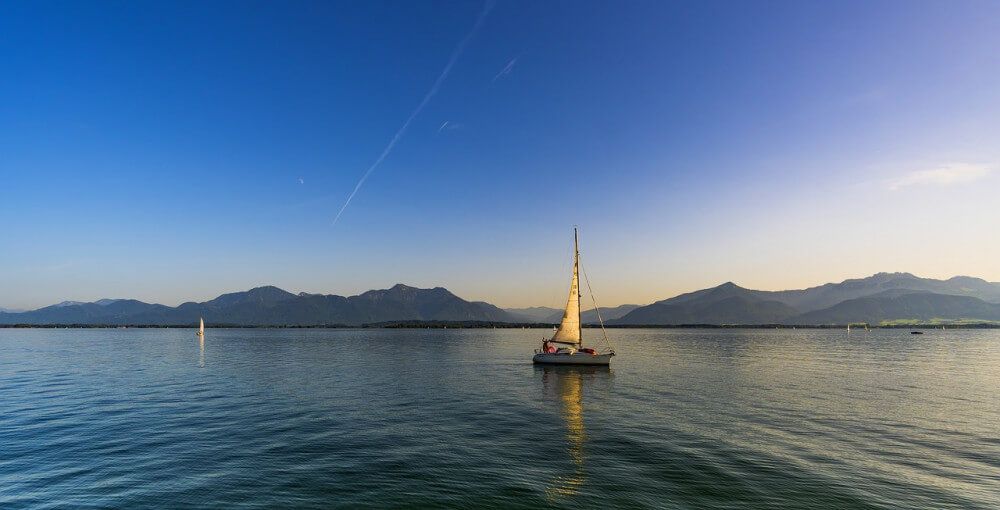
On this page:
Factors that determine speed, converting and calculating sailing speed, calculating the hull speed of your own boat, exceeding hull speed, amount of nautical miles, related questions.
So let's get a little more into detail on sailboat speed. The most important factor in determining the speed is the hull type. I have two rules of thumb for you. The first is: the less of the boat is under water, the faster it goes.
Here are the average cruising speeds for different hull types:
- Monohull - 6-8 knots
- Catamaran and trimarans - 9-10 knots
- Fastest monohull (world record circumnavigation) - 15.43 knots
- Fastest trimaran (world record circumnavigation) - 27 knots
Monohull - Your average sailboat is a monohull. Nearly all monohulls are displacement hulls. A displacement hull is under water, pushing the water away. This allows the boat to cut through the water more smoothly; this stabilizes the boat. If you want to make it go faster, you would have to raise the entire hull above the water. Later on I'll show you how to calculate the maximum hull speed of your boat.
Catamarans and Trimarans - These are planing hulls, meaning they are on top of the water. They displace less water, which is why they are faster. But a planing hull is less stable than a displacement hull. To compensate, catamarans and trimarans have two or three hulls, which makes them extremely buoyant. Since this is not your average sailboat I'll leave them out of this article.
The second factor is the length of the boat. It's the second rule of thumb: the longer the boat, the faster it goes. Each sailboat has a maximum hull speed, which it can't exceed (in theory). The hull speed is determined by the length of the boat.
Here are the maximum hull speeds for different monohull lengths:
| length | meters | knots | mph | km/h |
|---|---|---|---|---|
| 16 ft | 5 m | 5 | 5.8 | 9.3 |
| 26 ft | 8 m | 6.8 | 7.8 | 12.6 |
| 36 ft | 11 m | 8 | 9.2 | 14.8 |
| 40 ft | 12 m | 8.5 | 9.8 | 15.7 |
| 65 ft | 20 m | 10.8 | 12.4 | 20 |
| 80 ft | 24 m | 12 | 13.8 | 22.2 |
| 100 ft | 30 m | 13.4 | 15.4 | 24.8 |
| 144 ft | 44 m | 16 | 18.4 | 29.6 |
Please note: the maximum hull speed isn't the average sailing speed. It's the upper limit (in theory - read on to learn more).
The third and perhaps most obvious factor of course is wind direction and speed. If you plan a large voyage, for example, an ocean passage, make sure to check the dominant wind and direction for your time of year. You want to make sure to have as much downwind as you can get, and a favorable current as well. This is why most sailors choose to go eastward instead of westward when sailing the world.
If you want to know why going eastward is smart, I encourage you to read my previous article on sailing around the world here .
How to calculate necessary sailing speed
So imagine you need to get to dock in time. It's 50 miles away. You need to arrive at 2100 hours. It's currently 1500 hours. Would be handy to know at what speed you need to sail to make it in time.
The formula is simple:
nautical miles / time = average speed necessary
2100 - 1500 = 360 minutes 360 / 60 = 6 hours Your average speed should be: 50 NM / 6 = 8.3 knots
Converting knots to mph and km/h
To convert knots to mph or km/h, simply multiply the knots by the ratio below.
1 knot = 1.151 mph 1 knot = 1.852 km/h
Great, we have a good general idea of what to expect from our trustworthy vessels. If you want to go deeper, you can try to calculate the maximum hull speed of your own boat. Calculating the maximum speed is actually very simple. Now is the time to get out your calculator.
You calculate the maximum hull speed (HS) by taking the length in feet (lwl), get the square root, and multiplying it by 1.34.
HS = √ lwl * 1.34 HS = Hull Speed lwl = length at waterline
So a 80 feet boat has a maximum hull speed of:
√ 80 * 1.34 = 12 knots
A displacement hull has a maximum hull speed. Hull speed is a theoretical speed that tells us what the maximum efficient speed is. Everything above that speed costs a lot more energy. If you power your boat by engine, you can exceed the speed by pushing the hull over your own bow wave (this requires a lot of horsepowers though, and it isn't good for your engine).
If you're sailing instead, you can exceed your hull speed with the help of the weather. Let's call these surfing conditions (sounds good). This might happen to you when you're sailing downwind and the current pushes you forward simultaneously. This helps you to overtake your own bow wave. If this happens, the wavelength gets longer than the hull length: the water can't get out of the way fast enough. As a result, the boat starts to plane, increasing water resistance at the front. Congratulations: you're surfing on your own bow wave.
The increase in speed won't be mind blowing however (about 1 knot). The truth is: a displacement hull is bound to its speed. It just costs to much energy to propel it through the water. It's made to cut, not steamroll the water.
Sailboats don't travel lightning fast, but they do travel 24/7. Because of this, they can cover quite a bit of distance. What distance are we actually able to cover with conservative speeds?
The average sailboat covers a distance of roughly 100 nautical miles (NM) , at a speed of around 4.5 knots. This equals 115 miles or 185 km.
1 NM is 1.852 km or 1.151 mile
You can calculate the distance per day by simply multiplying the speed in knots by 24 hours:
NM = knots * 24
Most sailboats cover anywhere between 100-180 NM per day. This means that a fast sailboat in ideal conditions can cover more than 200 miles. Impressive. However, anything over 180 NM is uncommon. We usually only see cruising speeds that high in races.
Here are the distances per day (NM) for different cruising speeds:
| hull speed | NM | miles | km |
|---|---|---|---|
| 4 | 96 | 111 | 178 |
| 5 | 120 | 115 | 222 |
| 6 | 144 | 166 | 267 |
| 7 | 168 | 190 | 311 |
| 8 | 192 | 221 | 356 |
| 9 | 216 | 249 | 400 |
How fast can a sailboat go under power? The average speed of a sailboat under power is 4-5 knots (5 mph or 8 km/h). Most sailors switch to engine at sailing speeds below 6 knots, especially when on passage.
How fast do racing sailboats go? Racing sailboats can reach speeds of 30 - 50 knots (35-58 mph or 55-92 km/h). The record is set at 65.45 knots (75 mph or 121 km/h). They can beat wind speed because they have a planing hull instead of a displacement hull, making them a lot faster than average sailboats
Can a sailboat sail faster than the wind? Sailboats with a planing hull (multihulls) can go faster than wind. Displacement hulls (the average sailboat) can't beat the wind, or just slightly in surfing conditions.

Robert Tangney Kenmare Ireland
Just wondering if you could do a similar article on diesel powered boats.I have a Seaward 23 powered with two 1.6 mermaid engines.I normally do around 7_8 knots and was thinking of replacing them for more speed around 10_12 knots.what engines would I need. According to what I have read already I should be getting 10 knots cruising speed with a top speed of 12 knots.This is not the case and her bottom is very clean.Found your article very interesting.
Shawn Buckles
Hi Robert, thanks for your comment. You have quite a bit of power there, nice.
I wouldn’t know for sure what engine size you should get, this article is specifically about sailboats. Also, this is the maximum hull speed - what you could expect under ideal conditions. And that’s never the case - you have to deal with current, wind, and so on. So I’d say it sounds about right.
If by diesel-powered boats you mean a powerboat, I currently don’t write about powerboats. Maybe I will in the future, but I won’t make any promises for now.
Thanks again and good luck with your upgrade!
I’m not sure if you use a different way of calculating time in nautical terms (Not a sailor myself, just curious about sailboats), but in the ‘How to calculate necessary sailing speed’ my math would say there’s 6 hours = 360 minutes from 1500 hours (3 PM) to 2100 hours (9 PM), not 600 minutes = 10 hours. Am I missing something?
Hi Ben L, That’s exactly right, it was a math error on my part. Thanks for pointing it out, I have updated the article.
Catamarans and trimarans are PLANING boats?! How long have you been sailing? Three days? :-)))
Matas Pacevicius
Just wanted to point out a typo. At hull speed of 5NM you travel 120NM and 138miles (not the 115 written) per 24hrs. Thank you for your articles. I’ve been dreaming of circumnavigation for years and am in the process of designing and building my own sailboat for the feat. I would love to build and sail a sailboat on which I could live almost anywhere in the world. I currently reside on the Gulf coast of Florida and am surrounded by beautiful warm waters that beckon me to explore them. Hopefully in the followings 5 years I will be sailing into the Caribbean in my self-built traveling home in the water. I wish to call the oceans home and soon the entire world. I plan to cross the Atlantic from the Caribbean on my first leg around the world. Would you recommend sailing throughout the Mediterranean? Any ideas on how’s to make money along the way?
I’ve worked all my life, struggling. Now 56y.o. staring at becoming a jobless wanderer in the next couple of months, maybe pick up a used boat. I am just really curious how some people have the time and place to design, build, and then sail around. Tell me your secrets…
Benjamin Lindner
Hello Shawn;
You have an error in your table above: 5 Knots = 120 NM BUT DOES NOT EQUAL 115 MILES.
Thank you Ben
Carlos Alberto Molinelli
But WHY is it a maximum speed for displacement boats in quiet waters, responding to this old formula? It is because the speed increases, the water displaced forms waves. At slow speed there are several along the hull. At fast speed there are only two: one at the bow and another an the stern. If the boat tries to go faster, the stern wave would go more farther but the hull would lose sustentation. It better explained with a picture. Look for boats going fast. You will see only two waves.
Robert Flores
Getting close to retirement and want to get a sailboat with some power. Thinking about sailing lakes and coastal. Looking at the macgregor 26M and seaward 26rk. What recommendations do you have ?? Or things to think about. I am one for safety. Best regards Robert
Ronald Ernst van Dijk
Thank you. Very well explained in clear language, including the usual conversions between knots, miles and kilometers. It helps understanding the physics of sailboats and what to expect in terms of speed. I have just completed building an 18 feet wooden gaff rigged yawl (design by François Vivier) for single handed coastal sailing in Malaysia, the country where I live. Your “rule of thumb” about HS = Lwl * 1.34 seems to work well, although I have to further try it out with different wind speeds and sailing on a reach or down wind.
Your website is an ad horror show to the point it is not usable any more. Ads do have their place and purpose, just like food needs salt. But in your case there is more salt then there is food. Moderation is key.
Ara Houston
Hello improvesailing.com owner, You always provide helpful information.
Leave a comment
You may also like, how far can you sail in one day.
The average one-day sailing distance of a boat is important for planning passages. I've done the research and the same numbers kept coming up. Here they are.

How Much Fuel Does a Sailboat Use?
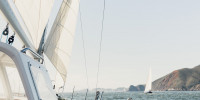
How To Sail Into the Wind (in 7 Simple Steps)
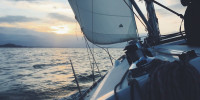
What’s the Largest Boat One Person Can Operate?

Sailboat Racing Tips: Speed Through Kindness
Where Kindness May Be Your Most Strategic Sailboat Racing Strategy
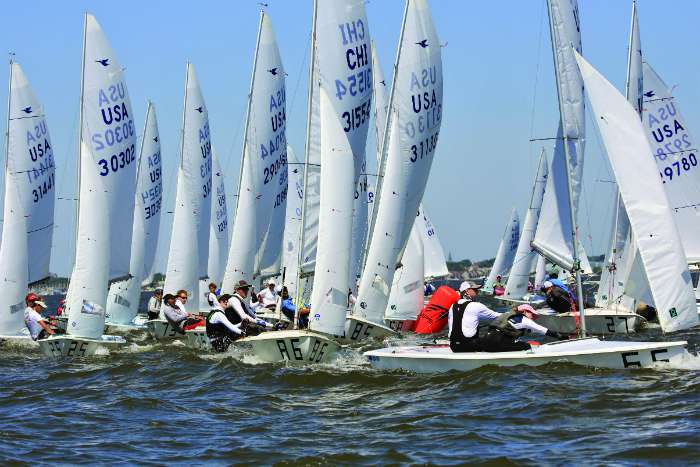
by Kim Couranz – published on SpinSheet
The overall objective in sailboat racing is to cross the finish line first—to sail the course faster than your competitors. While there are endless decisions to make toward achieving that goal, simply sailing fast is a (and sometimes, the) primary key to success.
Sailboat racing is also supposed to be fun. Being tangled up with other boats, or being distracted by what’s going on around you, isn’t fun or fast.
What does “tangled up” mean here? It can be literal or figurative; from getting your shrouds meshed with another boat to a little bumper boat action to getting yourself in bad air, tangled is slow. Distractions are slow, whether it’s something that draws your focus away from driving fast or if it’s thinking about how you’re going to write up that protest form from the situation that just happened.
You can often avoid getting tangled up or distracted by being kind to your competitors. There are a few spots on the racecourse where the benefits of being kind to other boats can pay off not only for them but for you as well.
Before, during, and just after your start is a critical time where you need to focus on getting your boat off the line. It’s not where you are right at the start but 30 seconds after the start! Are you able to start with fairly clean air and a lane you can keep going in for a bit? That’s the goal. Yes, sometimes when you’re on final approach to the line, you need to do a bit of squeezing in to get your spot. But rarely do you need to screw someone else to do that. Swooping in from up the line or tacking super tight to leeward of a boat already set up on starboard makes them alter course and also restricts your maneuverability.
Remember Racing Rules of Sailing #16, which notes that a right-of-way boat must give the other boat room to keep clear—so that if you come in to a starting line too close to leeward to another boat, and as they pivot and try to head up to keep clear of you, the back hip of their boat hits your windward side, there’s a good chance you didn’t give them enough room. And then, they are possibly on your air (not good for you getting rolling fast as the starting gun fires), and you may have some time in the protest room ahead of you (a short- and long-term distraction). The alternative? Be a little kind, give them a little more room, and everyone’s happy.
Mark roundings are another classic part of the racecourse where kindness can help you get around the course more quickly. Coming in near the weather mark on port tack, there’s a starboard tack boat you could either cross or plant a tight lee bow on, maybe on layline but maybe not? Crossing them and tacking above them not only lets them keep on trucking, but also means you don’t have to pinch (= slow) your way to the weather mark. True, they might round the weather mark before you, but you’ll be tight on their tail and on their breeze, ready to pass them downwind.
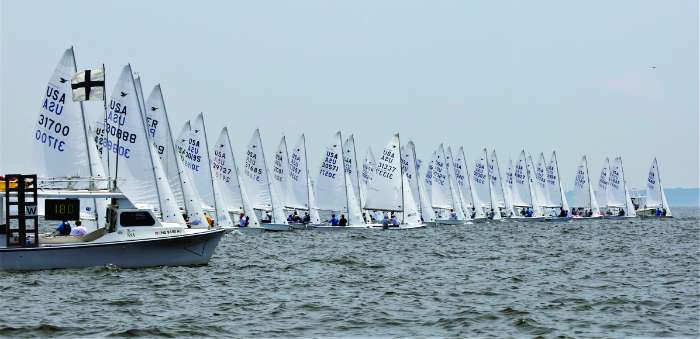
- Kim Couranz
Leave a reply
Your email address will not be published. Your comment will be revised by the site if needed.

Semana Internacional del Yachting
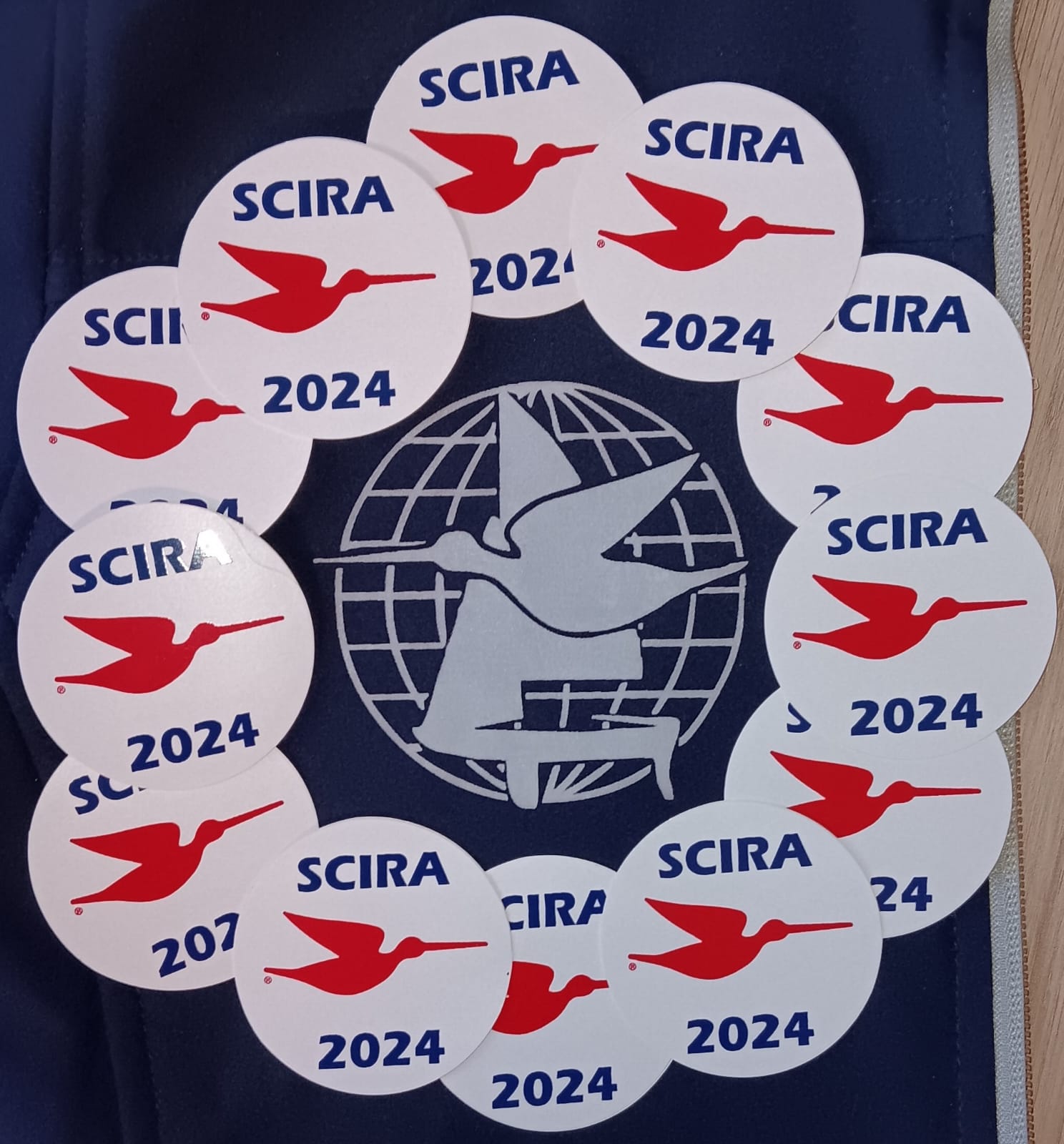
2024 SCIRA Decals
More content

All Japan Nationals – Final
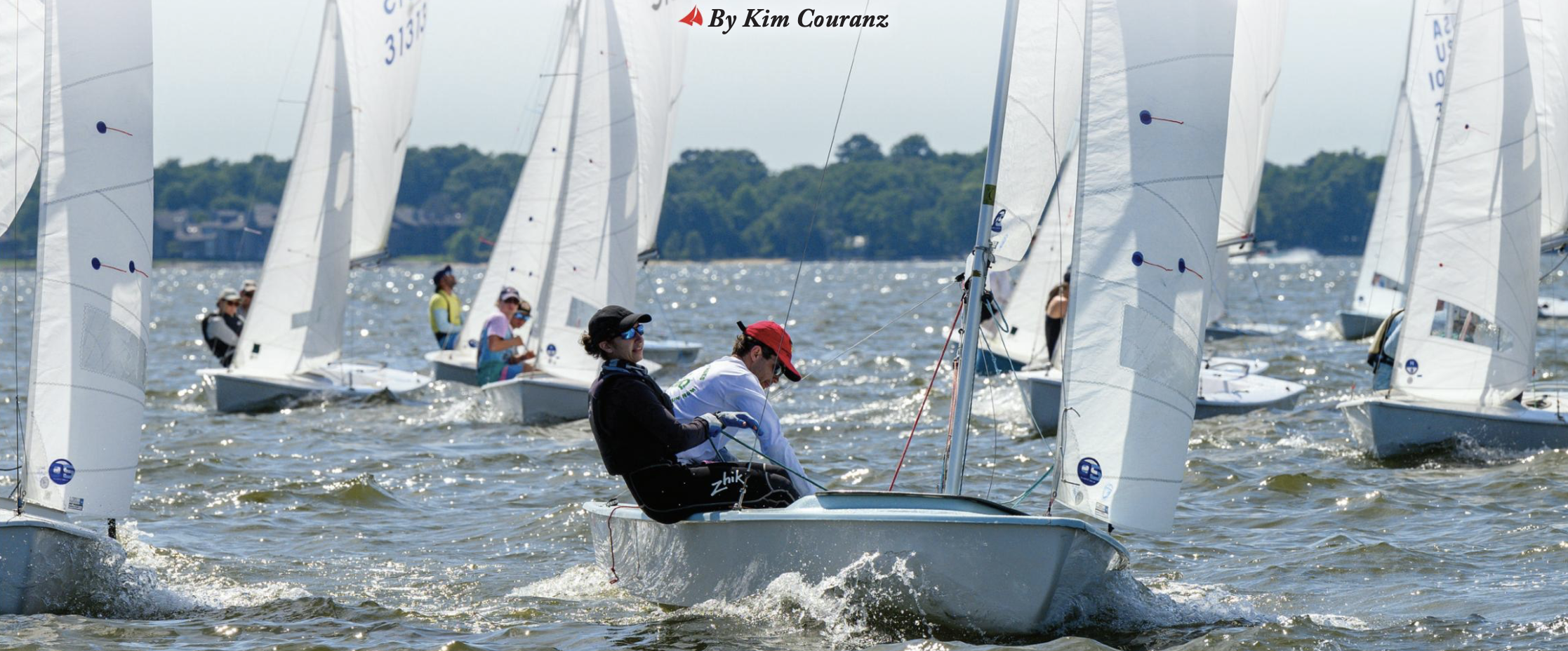
Take a Deep Breath, and Simplify!
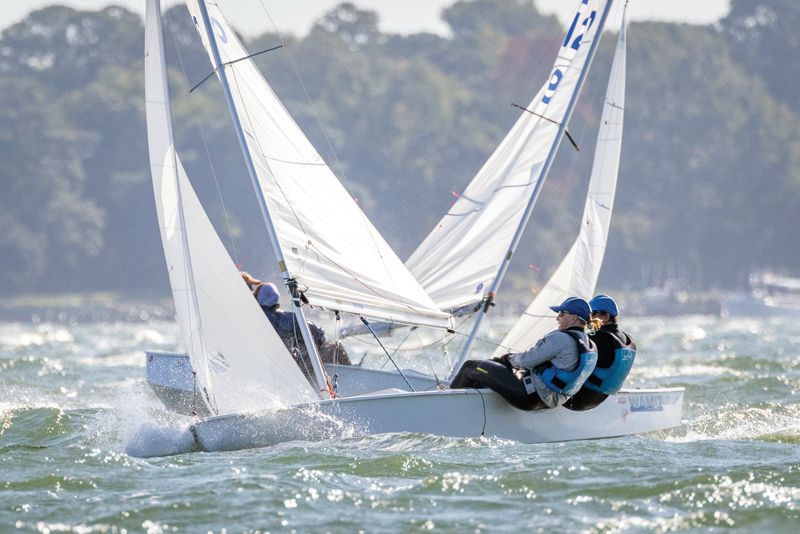
There’s More Than One Reason for Having a Game Plan at a Regatta

SnipeToday Video Conference: Regatta Preparation
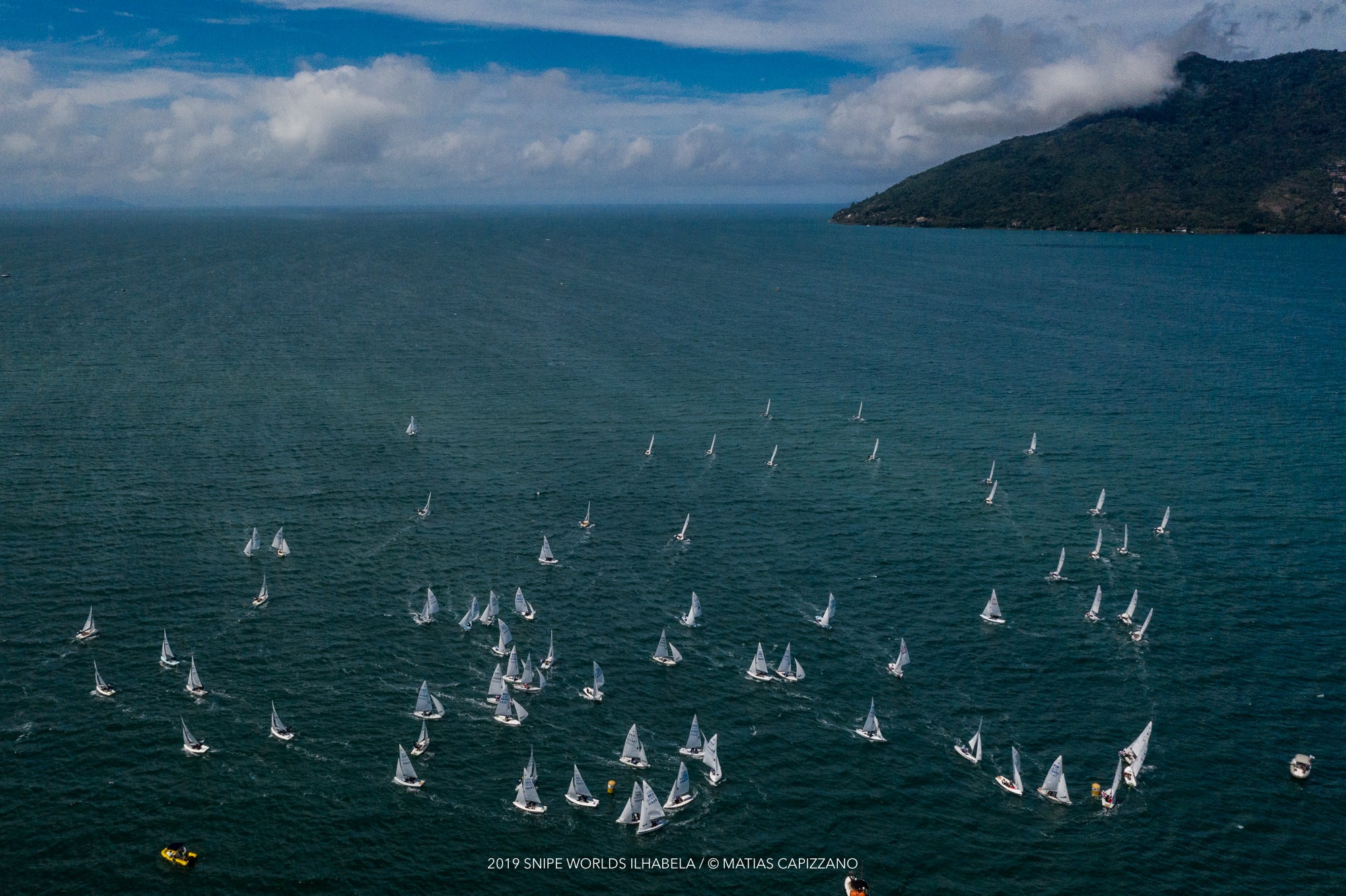
Choosing the “Right” Gate: My Top Ten Factors

Ridetheducksofseattle is reader-supported. When you buy through our links, we may earn an affiliate commission. Learn more
Average Speed of a Sailboat (How Fast Can a Sailboat Go?)
Written by Anthony Roberts / Fact checked by Jonathan Larson
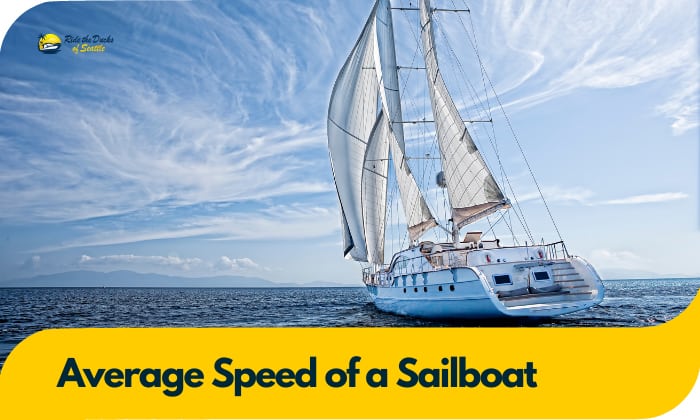
You might have seen how sailing yachts seem to outpace motorized boats in a regatta, prompting you to ask about the average speed of a sailboat. Although the record holder (the Vestas Sailrocket 2) can blitz to 65.5 knots, the run-off-the-mill sailing vessel can only reach four to six knots.
Several factors influence sailboat speeds, and we will examine each in this article. Please keep reading, so you will not miss the invaluable information you will get from this post.
Table of Contents
1. Hull shape
2. sailboat length, 1. alternative measurement, 2. converting knots to kph or mph, 1. hull type, tips to improve speed, frequently asked questions, how fast can a sailing vessel go.
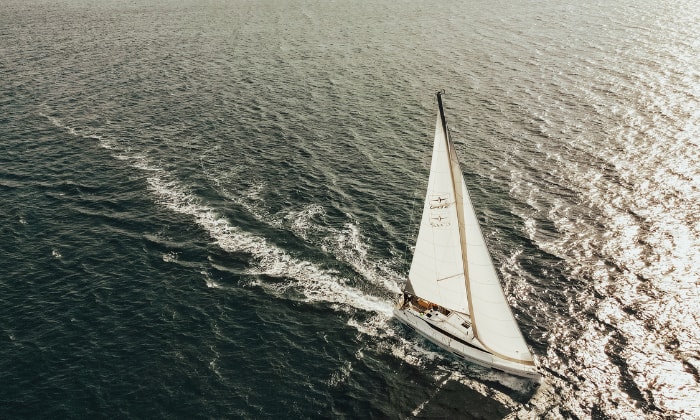
Regatta-competing racing sailboats can reach a top speed of about 20 knots, while custom-built high speed racing yachts can log 50 knots. As mentioned, the Vestas Sailrocket 2 blitzes the waters at a dizzying 65.5 knots (75.38 miles per hour or 121.31 kilometers per hour).
On the other hand, the average sailboat in lakes and other bodies of water can only top the speed charts at seven knots (8.06 MPH or 12.97 KPH), averaging about four to six knots (4.6 to 6.9 MPH or 7.4 to 11.1 KPH).
An 1800s or 1970s sailing ship (i.e., galleon or clipper) has about the same speed as the average modern sailboat. However, it is worth noting that the Sovereign of the Seas logged the highest velocity for a sail-powered ship at 22 knots (25.32 MPH or 40.75 KPH) in 1854.
Meanwhile, the fastest sailing dinghy is the International Moth, blasting the waters at 35.9 knots (41.3 MPH or 66.5 KPH).
So, why the variance?
Two intrinsic (within the boat itself) factors impact the speed of sailboat units. These include hull shape and vessel length.
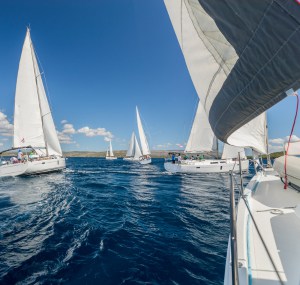
Racing sailboats are faster than cruising yachts because of their unique hull shape differences.
A sailboat built for speed has a super-slim hull and straight buttock lines. The aft section forms a straight line between the slightly wide transom and the hull’s lowest point.
Meanwhile, sluggish sailboats have a “fat tub” hull shape, a narrow stern, and a curvy hull.
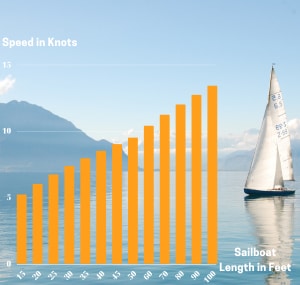
There is a scientific explanation about the impact of sailboat size (or length) on its speed. Sailing vessels create a wave pattern as they move along the water, one at the front and another at the back.
A water wave sufficient to help the boat move occurs if the sailboat’s length is similar to the length of the wave. This phenomenon “lifts” the vessel’s bow, increasing its speed while reducing water resistance.
Hence, a longer sailboat will have a greater cruising speed than short vessels because they can create longer waves.
We prepared the following table to illustrate how vessel length impacts sailboat speed. Hence, a 40 ft. sailboat will always be speedier than shorter sailing vessels (<40 feet).
| 15 | 5.19 |
| 20 | 5.99 |
| 25 | 6.7 |
| 30 | 7.34 |
| 35 | 7.93 |
| 40 | 8.48 |
| 45 | 8.99 |
| 50 | 9.48 |
| 60 | 10.38 |
| 70 | 11.21 |
| 80 | 11.98 |
| 90 | 12.71 |
| 100 | 13.4 |
How to Calculate the Speed
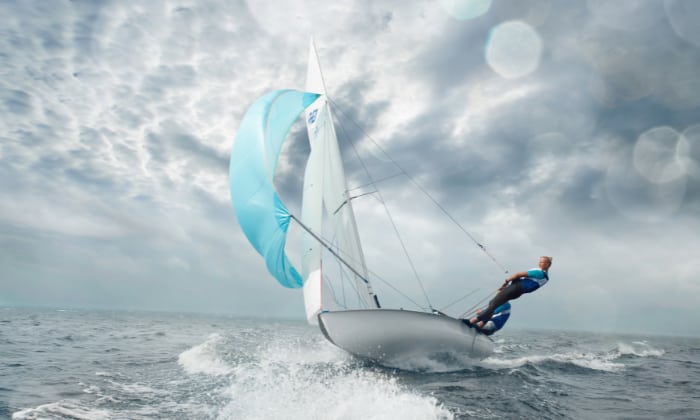
You can use an online sailboat speed calculator, input the required variables, and the system will automatically run the equation. Alternatively, you can determine your sailboat’s average speed by following this simple formula.
Average yacht speed knots = (√(LWL))x 1.34
In which “LWL” is your sailboat’s length at the waterline
Suppose you have a 36-foot sailboat that measures 26 feet at the waterline. The square root of 26 is 5.099. Multiplying this number by 1.34 will result in 6.832 or 6.8 knots.
How about a 59-foot sailing vessel with a waterline length of 47 feet? The square root of 47 is 6.86. We will get 9.19 knots after multiplying 6.86 by 1.34.
Please note that this sailboat speed is the average, provided you have clear skies, calm seas, and an ideal sailboat setup.
For example, suppose we achieved 6.8 knots with 15-knot winds and a sail setup of 50- to 120-degree true wind angle. We can expect our sailboat example to be slower if we do not achieve these conditions.
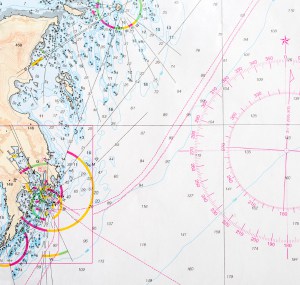
You can also determine your sailboat’s speed by sailing from one point to another. However, you might have to ascertain the distance between these two locations beforehand, and it should be in nautical miles (NM).
Why nautical miles? We are measuring sailboat speeds in knots. One knot is equivalent to one NM per hour. It is worth noting that one NM is 1.15 land-based miles, to put it in perspective.
Take the known distance between the two locations (in nautical miles) and divide the number by the time it took you to complete the journey.
For example, suppose you sailed from Buffalo, New York to Detroit, Michigan, with a distance of 186.99 nautical miles, and it took you 23 hours to complete the journey. In that case, 186.99 divided by 23 hours is 8.13 knots.
You can also take your average sailing distance per day to gain a more comprehensive understanding of your sailboat’s speed. For example, a sailboat with a 6-knot average speed can cover 144 nautical miles in 24 hours (6 x 24 = 144).
Something might be amiss if your boat sailed for 24 hours and covered less than 144 nautical miles. You might have more favorable sailing conditions if you traveled the distance in less than 24 hours.
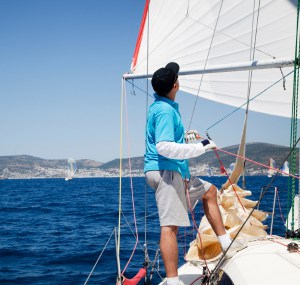
Sailors use “knots” as the unit of measure for vessel speed. Unfortunately, ordinary mortals are unfamiliar with this metric. They are more in tune with “miles per hour” (MPH) or “kilometers per hour” (km/h or KPH).
We mentioned that a nautical mile is slightly longer than a land-measured mile (1.15 statute miles). We also know that 1 NM per hour is 1 knot. Hence, we can multiply the “knot” value by 1.15 to determine your sailboat’s speed in MPH (miles per hour).
A mile is also longer than a kilometer (1 mile = 1.60934 kilometers). Thus, we can assume our KPH values will be higher than knots and MPH. We can multiply “knots” by 1.852 to get the value in KPH.
For example, a top speed sailboat blitzing at 50 knots has a maximum velocity of 57.5 MPH (50 knots x 1.15) or 92.6 KPH (50 knots x 1.852).
On the other hand, a 6.5-knot sailboat can only muster 7.475 MPH or 12.038 KPH.
Factors Affecting Sailboat Speed
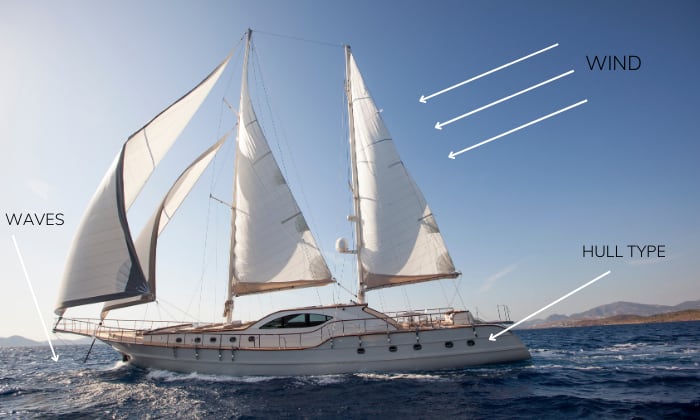
Although we already discussed hull shape and vessel length’s influence on sailboat speed, three other factors can impact watercraft velocity.
Sailboats with at least two hulls (catamarans) are 25 to 30 percent faster than monohulls, given equal lengths.
Hence, if a single-hulled sailboat can go six knots, we can expect a catamaran to have an average speed of 7.5 to 7.8 knots (8.625 to 8.97 MPH or 13.89 to 14.45 KPH). This sailboat hull can match a racing monohull sailboat’s velocity with better comfort.
Add another hull to the catamaran (a trimaran), and you can outpace a racing monohull by doubling its velocity.
Although some sailboats have engines, most rely on wind power for propulsion. Hence, stronger winds can make a sailboat go faster by pushing against the sail. Unfortunately, wind direction can also influence vessel speed. You can go fast if the wind blows in your heading.
You might be inclined to believe that calm waters can make your sailboat go faster. Unfortunately, serene waters often mean gentle winds. And if there is not much wind to push the sail, you cannot expect your vessel to go faster.
Current, wind, and wave or sea condition is the most important factor in determining a safe vessel speed. If the water is rough, it is safer to reduce speed because bad weather can impair visibility and make it challenging to maneuver the vessel.
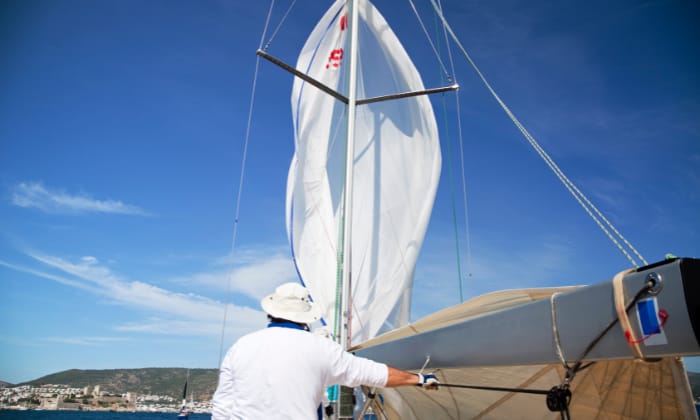
Here are some tips to improve sailboat speed.
- Ensure the sailboat’s proper operating condition, especially the mast, sail, and extrusions. Check the hull and foils.
- Be mindful of the sailboat’s maximum weight capacity, ensuring you do not exceed the rating. Moreover, the correct weight distribution can help you pilot the sailboat faster.
- You might want to brush up on your sailing competencies, including sail control, steering, sail angling, genoa and jib control, kite curling, efficient pumping, and wind positioning.
- Check your sailboat’s settings, including the shroud tension, mast rake, jib car position, mast step position, keel position, and vang tension.

Sailboat speed vs wind speed: which’s faster?
A vessel sailing faster than the wind is possible with a superiorly designed and streamlined hull and the correct sail angle. Otherwise, the sailboat will only be as fast as the wind speed on the sail.
It is also worth mentioning that sailboats with multiple hulls or a planing hull can be faster than wind speeds.
How fast can a sailboat go under power?
A sailboat under power can move on the water at an average velocity of four to five knots (nautical miles per hour) or 5 MPH (8 KPH). This is not very fast but not slow either.
Are catamarans or monohulls faster?
Multihulls (i.e., catamarans and trimarans) are faster than monohulls, averaging about nine to ten knots (10.35 to 11.5 MPH or 16.69 to 18.52 KPH). On the other hand, monohulls only average six to eight knots (6.9 to 9.2 MPH or 11.11 to 14.82 KPH).
The average speed of a sailboat varies across sailing vessel types, sailboat lengths, hull shapes, and hull types. Wind and waves can also influence sailboat velocity.
Given ideal weather conditions, the average sailing vessel can cruise at four to six knots. Custom-built, high-performance racing yachts can blitz the waters at up to 65 knots. Twin-hulled sailboats are 25 to 30 percent faster than their single-hull counterparts, while triple-hulls are super-quick.
Of course, everything depends on wave and wind conditions.\
Read more : The fastest speed of a boat.

Ten years of enjoying countless trips on boats never made me love them any less! So I am here to put all those experiences into good use for other boaters who want to have a safe and fun trip with their friends and families.
360+ Sailing Team Names You’ll Love

When it comes to building camaraderie on the high seas, having a memorable sailing team name can set the right tone and boost team spirit. A clever or funny name can not only bring laughter but also foster connection among team members.
So, what makes a sailing team name captivating? Humor? Creativity? A touch of nautical flair? The truth is, it can be a mix of all these elements! Imagine your team out on the ocean or competing in a race, and every time someone mentions your name, it evokes a sense of pride and unity. Doesn’t that sound amazing?
Creating the perfect name involves understanding your team’s personality and mission. What do you want to express? Are you fun-loving adventurers or serious competitors? Consider incorporating sailing terminology, puns, or themes related to the ocean to make your name stand out. Who knows? An inspired choice could also spark a great story or memorable moment that you’ll fondly recall for years to come.
So, ready to set sail into the world of creativity? Here are vibrant sailing team name ideas to jumpstart your brainstorming:
Sailing Team Names
- The Nautical Navigators
- Sail and Tails
- Mighty Seafarers
- Oceanic Warriors
- Wind Chasers
- Hull of Fame
- Wave Riders
- The Sailors’ Society
- Reef Runners
- Anchor Anchors
- Nauti by Nature
- Catch of the Day
- Buoyant Buccaneers
- Drifting Dreamers
- Windy Whispers
- Full Sail Force
- Sea Glass Sailors
- Crew-tastic!
- Navigate this!
- Starboard Stars
Check Out: 340+ Polo Team Names to Stand Out on the Field
- Windy Wanderers
- Sailor’s Delight
- Anchors Aweigh!
- Riptide Racers
- The Nautical Ninjas
- Ocean Odyssey
- Ahoy, Mateys!
- Seas the Day
- The Saltwater Sisters
- Chart Toppers
- The Regatta Rascals
- Salty Sea Dogs
- Ocean Outlaws
- Wave Warriors
- Buoy Scouts
- Crew and Aye!
- Go with the Flow
- Sea Breeze Brigade
- Windward Warriors
- The Great Sail Hope
- No Current Events
- California Rollers
- The Boat Bunch
Check Out: 350+ Handball Team Names for Every League
- Wayfarer Wonders
- On the Tide
- The Ocean’s Elites
- Life’s a Beach
- Skipper Squad
- Wave to the Future
- Boundless Blue
- Harbor Hustlers
- Pelagic Pioneers
- Oceans of Fun
- Beyond the Horizon
- Surf ‘n’ Turf Team
- The Wave Makers
- The Lighthouse League
- Sailor’s Quest
- Seagull Squad
- Charted Territory
- Reef Raiders
- Anchors Away Crew
- Bayside Heroes
- Marine Mavericks
- Seasational Sailors
- High Seas Hustlers
- Portside Protectors
- Ocean Dreamers
- Windward Wonders
- The Keel Deal Crew
- Wave Runners
Check Out: 360+ Racquetball Team Names to Inspire Your Next Match
- Castaway Crew
- Splash Zone Squad
- Beyond the Breakers
- Seas the Opportunity
- Lords of the Lagoon
- Maritime Marvels
- Briny Buccaneers
- Waves of Glory
- Adventurous Armada
- Nautical Navigators
- Skippers for Life
- Mariner Magic
- Ocean’s Guardians
- Wind and Waves
- Crew of the Sea
- Ocean Explorers
- Deckhands Delight
- All Hands on Deck
- Gentle Giants of the Sea
- Coastal Crusaders
- The Sirens’ Call
- Rough Seas Racers
- Sea Sons of the Beach
Check Out: 320+ Fencing Team Names – Stand Out on the Strip!
Sailing Team and Group Names
Nautical-themed names.
- Nautical Nomads
- Sailwave Mavericks
- Tidal Titans
- Sea Zephyrs
- Oceanic Oracles
- Breezy Buccaneers
- Horizon Hunters
- Blue Horizon Navigators
- Storm Surge Sailors
Check Out: 340+ Snowboarding Team Names to Inspire Your Squad
Pirate-Inspired Names
- The Jolly Rogers
- Black Pearl Crew
- Plunder Pirates
- Skull and Crossbones
- Rum Runners
- The Sea Marauders
- Buccaneer Brigade
- Scallywag Sailors
- Cannonball Crew
- Pirate Plunders
Check Out: 360+ Figure Skating Team Names That Stand Out
Adventure & Exploration
- Voyager Vessels
- Windward Wanderers
- Sea Trailblazers
- The Argonauts
- Horizon Voyagers
- Odyssey Mariners
- Adventure Armada
- Wind Whisperers
Check Out: 450+ Netball Team Names – Ideas for Every Squad
Speed & Power
- Windrush Warriors
- Gale Force Gladiators
- Velocity Vessels
- Speedwave Squad
- Turbo Tides
- Velocity Vikings
- Swift Sailors
- Jetstream Jockeys
- Rapid Rudders
- Powerboat Patriots
Check Out: 380+ Frisbee Team Names to Inspire Your Squad
Mythology & Legend
- Poseidon’s Pirates
- Neptune’s Navigators
- Trident Troupe
- Siren’s Song Sailors
- The Kraken Crew
- Cyclone Centurions
- Argonaut Armada
- Triton’s Titans
- Atlas Armada
- Selkie Sailors
Check Out: 340+ Drifting Team Names to Rev Up Your Racing Spirit
Weather & Elements
- Stormfront Sailors
- Thunder Tide
- Lightning Lasers
- Zephyr Zealots
- Tornado Tides
- Tempest Titans
- Cloud Chasers
- Solar Wind Warriors
- Rainmaker Raiders
- Gusty Gladiators
Check Out: 360+ Rugby Team Names – Unique Ideas for Your Squad
Humorous Names
- Knotty Buoys
- The Salty Dogs
- Water Logged
- Bow Movement
- Sailor Jerry’s Juggernauts
- Stern Faces
- Riggity Wrecked
- Windbreakers
- Ahoy Mates!
Check Out: 350+ Skateboarding Team Names to Inspire Your Crew
Wildlife & Nature
- Dolphin Dashers
- Whale Watchers
- Albatross Armada
- Seagull Squadron
- Pelican Prowlers
- Sharkfin Sailors
- Orca Odyssey
- Marlin Mariners
- Manta Ray Racers
- Seabird Sailors
Check Out: 360+ Hunting Team Names for Your Group
Ocean & Water
- Deep Blue Drifters
- Sea Spray Squad
- Coral Crusaders
- Aqua Armada
- Ocean’s Emissaries
- The Blue Tide
- Nautical Nebula
- Waterway Warriors
Check Out: 350+ Camping Team Names for Your Next Outdoor Adventure
Teamwork & Unity
- United Sails
- The Anchored Crew
- Sail Together
- Seamless Sync
- Unity Under Sail
- Crew Collaborative
- Synchronized Sailors
- Cohesive Currents
- The Linked Lines
Check Out: 350+ Surfing Team Names to Inspire Your Crew
Once you’ve chosen a name that resonates with your group, don’t stop there! Celebrate its uniqueness. Share it with pride on social media, create matching team shirts, or even bring it to life with a team logo. Transforming your name into a tangible symbol enhances your identity and can bond your crew more tightly.
Remember, the journey is just as important as the destination, so enjoy the ride! With the wind at your back and a great name in your sails, the possibilities are endless. Now, who’s ready to chart a course for adventure?

Positions on a Racing Sailboat

Last Updated by
Gabriel Hannon
August 30, 2022
The success of a racing sailboat depends entirely on the ability of each person on the boat to know and execute their role in high-pressure situations.
While boat-dependent, all positions are some combination of the responsibilities of driver, bow, tactician, trimmer, and pit. The driver makes the final decisions and steers, while the other crew members play various roles providing information, trimming sails, and keeping the boat moving fast.
The fundamental responsibilities of sailboat racing do not change, regardless of the number of people aboard. Someone in a one-person dinghy has to be able to keep track of the course, make tactical decisions, trim sails, steer, watch for new breeze and other boats, and ensure that they are set up for the next leg. On a larger boat, with more sails, more controls, and more required coordination, these jobs still exist and are distributed amongst various crew members. We will go through the basic crew setups of various one-design racing boats from one through four crew members to develop how the increase in crew and complexity begins to distribute the responsibilities of making the boat go fast across the team. Then, we will make some general claims about bigger boats, but as everything gets more confusing in the larger crews, we will not specify too much.
Over years of racing boats of all sizes, I’ve seen these crew roles respond to personal skills, different boat setups, strange habits, and teamwork to the point where everyone can respond to different events seamlessly. Sometimes these roles are perfectly well-defined, but sometimes a quick-thinking crew will switch positions on a dime to make up for a mistake in an entirely unorthodox way that is somehow perfect. On smaller boats, people have different priorities and different ways to work through all their responsibilities, but on all the best boats it is the people who know how to excel in their role, and how to make life easier for all their teammates by knowing exactly what they need, who make a sailboat go. Let’s get into it!
Table of contents
The One-Person Dinghy: It’s All on You
You could argue that sailing, at its most basic, boils down to one sailor, a handful of lines, and a tiller against the breeze and water. Perhaps it would be a ridiculous argument, as sailing has always relied on people working together, but there is something to seeing who can go out there and be the one to make it work the best. When all the responsibilities for every inch of the boat fall on one person, it is interesting to see who has everything in sync the best. There is no specific title for this position, but I suppose you could call them
The Single-Handed Sailor
There are fundamentally three aspects to sailboat racing: boat speed, boat handling, and tactics. The single-handed sailor has to excel in each dimension. The best case study for a single-handed boat is the ILCA Dingy, once known as the Laser, but other notable racers include the Opti, Finn, RS Aero, Moth, and Wazsp classes.
Boat speed comes down to trimming the sails properly for the angle to the wind. This means adjusting not only how far in and out the sail is, but also tuning specific control lines to give the sail the ideal shape for wind strength and direction. Making micro-adjustments to sail trim while dealing with all the other aspects of the race may not seem like much, but they can make the difference between winning and falling behind. While on larger boats there are entire positions dedicated to this, the single-handed sailor has to deal with this the whole time.
Other factors in boat speed concern steering through the wind shifts and wave sequences properly and keeping the boat flat by hiking out. This often includes being able to shift weight in precise ways to keep the boat optimally balanced and cutting through the waves.
Boat Handling
While boat speed forms the basis of all sailing, it is also crucial to know how to maneuver the boat through course changes. Windows in sailing races are small, and being able to get a boat into a lane is often a fraught affair. Having the confidence to trim the sails properly and maneuver sharply while still maintaining speed is a huge boost to a racer. Turning points at marks or directional switches while tacking and gybing are where many of the gains in a race come, and a clean tack coming into the top mark on port can mean the difference between leading the fleet and having to duck behind a parade of 30 boats. Being able to put on the brakes and accelerate quickly is key in tight spaces along the start line, and is a weapon for the best sailors.
Singlehanded racers have total control over their boat handling. Changes in direction come down to perfect synchronization of sail trim, steering, and body weight, and the single-handed sailor has to account for how every single adjustment affects these maneuvers. Some of the best boat handlers grow up racing single-handed boats; the feel developed sailing solo is hard to beat but requires years of fine-tuning and muscle memory.
All the speed and maneuverability in the world does not do much if you don’t know where to put the boat. Like any sport, the fundamentals are simple, but becoming a master takes a lifetime. The single-handed sailor must hold the entire course, the regularity of the wind shifts, the tendencies of the current, the positions of the other sailors, and their own plans in the front of their minds while pushing the boat as hard as possible.
While this is no place to discuss the intricacies of upwind tactics or the fastest lines on a downwind in different boats, the singlehanded sailor has to be able to think and make decisions tactically then execute those decisions themselves. This is such a large task that bigger boats will often have someone whose entire job is just to call breeze and tactics.
The single-handed sailor is without a doubt a jack-of-all-trades. We will discuss various terms for different crew-members on bigger boats, and while you could use the terms ‘skipper’ or ‘driver’ for the single-handed sailor, this does not quite say it all, so we save these positions for the bigger boats. We will not explicitly break the other boats down by who is in charge of boat speed, boat handling, and tactics, but roles can generally sort into various levels of responsibility for these categories.
The Two-Person Racer: The Best (or worst) Way to Get to Know Another Person
On a two-person boat, of which common examples include the various 420 classes, the Olympic Classes (470, 49er, Nacra 17) among many others, responsibilities are slightly split, but this distribution comes with the tradeoff of greatly increased complexity and coordination requirements. Double-handed boats tend to have at least two, and often three, sails, require more involved tuning, move much faster, and occasionally require single or double trapezing. The very best doublehanded pairings move as one, but this type of coordination requires both sailors to have an intimate knowledge of their role and the dynamic balance of the boat. Without further ado, the common positions:
The Skipper (Driver)
The skipper of the boat steers the boat. On different types of boats, they have different trimming and setting responsibilities, most often including the mainsheet--though the 49er is a notable exception. You can call them either a skipper or a driver, but you rarely say that ‘you skipper;’ instead, you would say that ‘you drive,’ so the latter term has begun to stick as the position as well.
As they are the person driving the boat, the driver tends to make the final tactical decision. They do this in collaboration with the crew, who is often going to be feeding information about the course and competitors to the driver, but the final decision comes down to the person holding the stick (forgive the vernacular, if you may).
Different double-handed teams often have different dynamics. In some, the driver will primarily be focused on tactics, while the crew has to keep their head in the boat making it go fast, while in others the skipper lets the crew make such calls while focusing on the breeze right in front of them, it all depends. Boat handling requires nigh on perfect coordination, and skippers must keep their crews alerted to any upcoming maneuvers.
The unsung heroes of many a double-handed pairing, a good driver can sail well with an ok crew, but a crack crew can take a skipper with some potential to the top of the fleet.
Responsible for trimming the headsail and setting and managing the spinnaker on boats that carry them, the crew’s primary roles is to keep the boat going fast. They often can make the small sail trim and control adjustments that the driver cannot. Especially upwind, the crew scans the course for new breeze, other boats, lay lines, and any information that the skipper could need to make the best decisions possible.
A good way to consider some, but not all, skipper-crew relationships is that the crew can get all the micro-considerations out of the way so that the skipper can focus on the big picture. The small picture adjustments in terms of sail control and angle of heel keep the boat moving and the skipper zippered into the feel of the course. In turn, this allows the skipper to plan ahead and keep the crew involved in decision making, making sure that they don’t screw their crew with a crash tack or sudden gybe.
Still, on some teams, the crew makes all of the outside the boat decisions while the driver just drives the boat as fast as they can. This often works with spacier skippers, of which there are many, and highlights the value of a strong-willed crew. Crews are often on-the-water coaches for high-strung skippers and are key to the success of a team. On more athletic boats, a crew can crucially contribute to boat speed and handling through trimming, ooching, and body-weight adjustments.
All of this is to say that a crew, both as a single person on a double-handed boat and as an ensemble on larger boats, is never to be considered an accessory to the skipper, but are crucial parts of a competitive racing team.
The Three or Four Person Boat: I Thought That Was Your Job!
Having outlined the general dynamics of a skipper-crew pairing, it is not particularly helpful to discuss exact boat setups and interactions. From here, we will provide terms and positions with general roles. These are all subject to change, but once you reach boats of three or more people, roles become highly specialized, as boats of this size begin to get complex enough that you cannot do everything on your own. Let’s run through the general roles that must be filled on boats of up to four, with the knowledge that these can be switched around and combined depending on skill, boat setup, and breeze.
Things change yet they stay ever the same. The bigger the boat, the more boat the driver has to deal with, but the role does not fundamentally change. The driver still has their hand on the stick, and, despite the best attempts of various crewmembers, still is the final decision maker on the boat. Sometimes they will trim the mainsheet as well, but other times they will leave this to a member of the crew
The bigger the boat, the less running around the skipper does and the more focused they are on sailing the perfect line through the fleet. Even their ability to scan the course and make tactical evaluations wanes on the bigger boats, as they must put more trust in their crews to make the right reads. They are still ultimately responsible for putting the boat in the right spot, but they are ultimately unable to control everything that is happening on the boat.
Debatably the easiest analog to the crew on a double-handed boat, the bow is, if nothing else, the most likely person on the boat to get soaking wet. Sitting the farthest forward, they are occasionally responsible for trimming the jib--particularly on three-person boats--but primarily have to deal with setting the spinnaker and dealing with front-of-boat controls.
They can play a role calling tactics, breeze, and other boats, but because they are so often busy with the chaos of boat handling in crucial spots and are often far away from the skipper, they mostly need to focus on their role setting the chute and managing the complications near the front of the boat.
Trimmer/Tactician
Often sitting at the hip of the skipper, different boats have different assignments for their trimmers, which can range from main-trimming across the whole course to only touching the spinnaker off the breeze to controlling the jib instead of the bow. Regardless of the particulars, they need to make the adjustments that keep the boat moving fast, and need to be continually in sync with how the skipper wants to sail.
The person in this position is often responsible for communicating details about the course and from the rest of the crew to the driver. Their role gives them more time to look around and make fine adjustments, rather than having a continuous responsibility, so they are in the perfect position to survey the information at hand and collaborate with the skipper on decision making.
On three-person boats, this is generally one person playing both roles in active collaboration with a driver. On certain four-person boats, this can lead to two trimmers who alternate between calling tactics and trimming different sails depending on the leg. Other times, this role is fully bifurcated, with one person trimming and another entirely responsible for looking around and making calls, with only a menial role controlling the sails, but this looks different on every team.
While Nascar has its pit crews, beginning at four-person boats, sailing just has its pit person. As boats get bigger, sails and various lines are more prone to twists, knots, and the generalized snarls that give sailors across the world excuses to flex their famous propensity for swearing.
The pit is responsible for eliminating, or at least minimizing, these disasters via preventative prep. They do not have a conventional job trimming sails, per se, but they are the ones who make sure that everyone else can the sails set cleanly. They prefeed sheets, ‘run the tapes’ on off-the-breeze sails to make sure they aren’t twisted and are notorious neat freaks. They often are responsible for raising and lowering sails around mark roundings; these events are almost always chaotic and never go according to plan, so it is the pit who has to coordinate the chaos as much as possible and clean up the mess in time for the next explosion. Unheralded, often stuck below decks, the pit can be the difference between a boat running smoothly and a stream of curses over a huge gash in a thousand dollar spinnaker.
Now This Is Getting Ridiculous: The Road to Specialization
As of this point, we have covered the key roles on just about any sized boat. As you get to bigger and more specialized boats, the situations will call for more and more crew members doing increasingly focused work. While having talented sailors on a larger boat is no less important than having them on a smaller dinghy, there are simply not that many parts that have to be moving all the time to fully occupy more than a few people at a time.
Still, when they are needed, during gybes, mark roundings, sets, and douses, these extra crew members are crucial. On certain boats, there is an entire position dedicated to trimming the twings during gybes; the position is only slightly more serious than the sound of the ropes. Still, the other crew members are so busy during the gybes that they need the extra pair of hands. Furthermore, having a sharp sailor in a position like that ensures another pair of eyes and hands to spot problems and step in if needed. Knowledge and quick action are unlikely to go unappreciated on any boat, even if it is only in a very specific setting.
There is, however, one more term for extra crew members on boats of this size, and it is distinctly unspecialized: meet the ‘rail meat.’ On sufficiently big boats, where heeling is slow but a fact of life, every now and then you just need a big ole guy to sit on the edge and hang out to windward. A flat boat is a fast boat, and sometimes you just need someone hanging out over the rail, skilled and mobile or not.
Finally, on high-performance boats, like America’s Cup boats or the new-fangled SailGP league, rail meat is replaced by ‘grinders,’ who specialize in turning hydraulic cranks like they’re in a CrossFit gym. Sometimes drawn from other sports, famously including rugby players on New Zealand’s America’s Cup team, grinders may not have the tactical acumen to step into a single-handed boat and win the day, but they are key pieces to winning teams and are no less a sailor than anyone else.
Hopefully, next time you go down to the water and someone tells you they need someone to run their bow, this has done enough for you to know exactly what you’ve gotten yourself into! Happy sailing!
Related Articles
I have been sailing since I was 7 years old. Since then I've been a US sailing certified instructor for over 8 years, raced at every level of one-design and college sailing in fleet, team, and match racing, and love sharing my knowledge of sailing with others!
by this author
Most Recent

What Does "Sailing By The Lee" Mean?
Daniel Wade
October 3, 2023

The Best Sailing Schools And Programs: Reviews & Ratings
September 26, 2023
Important Legal Info
Lifeofsailing.com is a participant in the Amazon Services LLC Associates Program, an affiliate advertising program designed to provide a means for sites to earn advertising fees by advertising and linking to Amazon. This site also participates in other affiliate programs and is compensated for referring traffic and business to these companies.
Similar Posts

How To Choose The Right Sailing Instructor
August 16, 2023

Basics Of Sailboat Racing Explained
May 29, 2023

Cost To Sail Around The World
May 16, 2023
Popular Posts

Best Liveaboard Catamaran Sailboats
December 28, 2023

Can a Novice Sail Around the World?
Elizabeth O'Malley
June 15, 2022

4 Best Electric Outboard Motors

How Long Did It Take The Vikings To Sail To England?

10 Best Sailboat Brands (And Why)
December 20, 2023

7 Best Places To Liveaboard A Sailboat
Get the best sailing content.
Top Rated Posts
Lifeofsailing.com is a participant in the Amazon Services LLC Associates Program, an affiliate advertising program designed to provide a means for sites to earn advertising fees by advertising and linking to Amazon. This site also participates in other affiliate programs and is compensated for referring traffic and business to these companies. (866) 342-SAIL
© 2024 Life of Sailing Email: [email protected] Address: 11816 Inwood Rd #3024 Dallas, TX 75244 Disclaimer Privacy Policy

- Toys & Games
- Remote & App Controlled Vehicles & Parts
- Remote & App Controlled Vehicles
Add to your order

- No Additional Cost: You pay nothing for repairs – parts, labor, and shipping included.
- Coverage: Plan starts on the date of purchase. If portable, drops, spills and cracked screens due to normal use are covered from day one. Malfunctions covered after the manufacturer's warranty. Real experts are available 24/7 to help with set-up, connectivity issues, troubleshooting and much more.
- Easy Claims Process: File a claim anytime online or by phone. Most claims approved within minutes. We will send you an e-gift card for the purchase price of your covered product. In some instances, we will replace or repair it.
- Product Eligibility: Plan must be purchased with a product or within 30 days of the product purchase. Pre-existing conditions are not covered.
- Terms & Details: More information about this protection plan is available within the “Product guides and documents” section. Simply click “User Guide” for more info. Terms & Conditions will be available in Your Orders on Amazon. Asurion will also email your plan confirmation with Terms & Conditions to the address associated with your Amazon account within 24 hours of purchase.
- Buy a lot of stuff on Amazon? Tons of items eligible for coverage, from the latest tech like Laptops, Game Consoles, TVs, Phones, and Cameras to major appliances, sporting goods, tools, toys, personal care, furniture, and more.
- Accidents Happen. That’s why for your portable products we cover accidental damage from handling such as drops, spills and cracked screens. We also cover electrical and mechanical malfunctions, power surges, and wear and tear.
- Past and Future Purchases covered. 30 days after you are enrolled, all eligible past purchases (up to 1 year prior to enrollment) and future eligible purchases made on Amazon will be covered by your plan as long as you are enrolled.
- Fast, easy claims. Frustration-Free claims, with most filed in minutes. We will fix it, replace it, or reimburse you with an Amazon e-gift card for the purchase price of your product (excluding tax). File at Asurion.com/amazon.
- No Hidden Fees. For just $16.99 a month + tax you’re covered for up to $5,000 in claims per 12-month period. *THIS PROGRAM IS MONTH-TO-MONTH AND WILL CONTINUE UNTIL CANCELED* Coverage for all products ends 30 days after the plan is canceled. Cancel any time.

Enjoy fast, free delivery, exclusive deals, and award-winning movies & TV shows with Prime Try Prime and start saving today with fast, free delivery
Amazon Prime includes:
Fast, FREE Delivery is available to Prime members. To join, select "Try Amazon Prime and start saving today with Fast, FREE Delivery" below the Add to Cart button.
- Cardmembers earn 5% Back at Amazon.com with a Prime Credit Card.
- Unlimited Free Two-Day Delivery
- Streaming of thousands of movies and TV shows with limited ads on Prime Video.
- A Kindle book to borrow for free each month - with no due dates
- Listen to over 2 million songs and hundreds of playlists
- Unlimited photo storage with anywhere access
Important: Your credit card will NOT be charged when you start your free trial or if you cancel during the trial period. If you're happy with Amazon Prime, do nothing. At the end of the free trial, your membership will automatically upgrade to a monthly membership.
Return this item for free
We offer easy, convenient returns with at least one free return option: no shipping charges. All returns must comply with our returns policy.
- Go to your orders and start the return
- Select your preferred free shipping option
- Drop off and leave!
2 Year Toy Accident Protection Plan
3 year toy accident protection plan, asurion complete protect: one plan covers all eligible past and future purchases on amazon.

Image Unavailable

- To view this video download Flash Player
ALPHAREV RC Boat - R308 20+ MPH Fast Remote Control Boat for Pool & Lake w/Hydro Dipped Speed Boat Hull, Portable Suitcase, 2.4Ghz Racing RC Boats for Adults & Kids w/Self-Righting, One Key Demo

Purchase options and add-ons
High-speed RC Boat - Built in with 370S brushed motor and 7.4V 1200mAh high-capacity battery, this RC toy reach a maximum speed up to 20+MPH. Our RC boats for adults and kids can drive in the pools, lakes, and seas, increasing summer joy with these RC water toys.
- Portable-to-take RC Boat Suitcase - R308 series remote control boat comes with a portable suitcase that includes mesh bags and customized slots to store the remote control speed boat and parts. It is portable to take anywhere.
- Water-Sensing Protection - For the safety concerns, only when the RC boat toy contacts the water will it starts the engine, which is safer for kids to operate. Decorated with LEDs, it optimizes the utmost lighting effect and indicates the directions when you drive the RC boat at night.
- Capsize Recovery & Auto Demo Functions - The 180-degeree capsize recovery functions makes the RC speed boat fearless about the winds and waves. The auto-demo function will enable the fast RC boat to showcase automatic driving stunts in eight-shape.
- Ultra Control Distance & Low-battery Warning - The control range of this remote control boat for boys is up to 300ft, which are ideal pool toys in summer. When the rc boats for kids in low battery, the transmitter will make "Beeping" sounds to remind you of calling back the outdoor water toys.
- Ideal Gift for Kids & Adults - The remote control boat with a delicate package is an ideal birthday gifts for boys and girls. Of course, It is also an ideal gift for Christmas, Children's Day, parties, or various occasions.
- 24hrs After-Sales Service: Our after-sales team will provide you with satisfactory service in 24 hours. Feel free to let us know if you have any questions about these rc boats or other water toys.
- Warning: DO NOT touch the outlet of the water cooling system. Beware of burns on your hands!
- Related Tags: rc boat, remote control boat, rc speed boat, speed boat remote control, radio controlled boat, rc toys, water toys, pool toys, outdoor water toys, rc boats for adults, rc boats for kids, rc boats for kids 8-12, rc water toys, remote control boat for adults, remote control boat for boys 4-7, remote control boat for boys 8-12, remote control boat for pool.
Consider a similar item

Frequently bought together

Customers who bought this item also bought

Product information
| Package Dimensions | 16.02 x 9.02 x 5.35 inches |
|---|---|
| Item Weight | 8 ounces |
| ASIN | B0CFF3CGJ8 |
| Item model number | R308 |
| Manufacturer recommended age | 14 years and up |
| Batteries | 1 Lithium Ion batteries required. (included) |
| Best Sellers Rank | #28,366 in Toys & Games ( ) #29 in |
| Customer Reviews | 4.2 out of 5 stars |
| Manufacturer | ALPHAREV |
Warranty & Support
Product Description
Important information, safety information.
DO NOT touch the outlet of the water cooling system.Beware of burns on your hands!
What's in the box
- RC Boat Suitcase, Remote Control, Batteries, [Other Parts]
Videos for this product

Click to play video

Customer Review: Broken piece
ALPHAREV - R308 RC Boat
MijibaobeiSupply

ALPHAREV-Jumping the Boat in The Sea

Customer Review: My husband loves it!!

Customer Review: Awesome
Avid Reader/New Listener

Customer Review: Second time out, not so great
Looking for specific info, customer reviews.
- 5 star 4 star 3 star 2 star 1 star 5 star 70% 11% 5% 3% 12% 70%
- 5 star 4 star 3 star 2 star 1 star 4 star 70% 11% 5% 3% 12% 11%
- 5 star 4 star 3 star 2 star 1 star 3 star 70% 11% 5% 3% 12% 5%
- 5 star 4 star 3 star 2 star 1 star 2 star 70% 11% 5% 3% 12% 3%
- 5 star 4 star 3 star 2 star 1 star 1 star 70% 11% 5% 3% 12% 12%
Customer Reviews, including Product Star Ratings help customers to learn more about the product and decide whether it is the right product for them.
To calculate the overall star rating and percentage breakdown by star, we don’t use a simple average. Instead, our system considers things like how recent a review is and if the reviewer bought the item on Amazon. It also analyzed reviews to verify trustworthiness.
Customers say
Customers like the ease of operation, maneuverability, and speed of the boat. For example, they mention it's fun to drive, has good steering control, and is very fast. That said, opinions are mixed on quality, battery life, and flipability.
AI-generated from the text of customer reviews
Customers like the speed of the boat. They mention that it is very fast, has different speed levels, and is easy to maneuver. Some appreciate the charging speed and the carrying case.
"...the boat zips around the pond at amazing speeds and the turning is quick.with my toddler at the controls, we have no flipped once...." Read more
"Great R/C boat. Very fun and fast ." Read more
"...Was fun and fast and handled well….for the handful of times we got to drive it." Read more
"...He loves it and can operate it perfectly. It is fast and maneuverable and seems to run a while on a charge (more than his attention span)...." Read more
Customers find the boat easy to operate and fun to drive. They say it's a great toy for children and also mention it'll have fun in the pool.
"Great R/C boat. Very fun and fast." Read more
"... Was fun and fast and handled well….for the handful of times we got to drive it." Read more
"This boat is very easy to use and is super fun to drive ! Has to be in the water to connect to the controller...." Read more
"...Customer service was very helpful. The boat drives great and is very entertaining !" Read more
Customers find the boat easy to use and fun to drive. They say it's easy to put together and perfect for beginners. Customers also mention that it runs for easily 20 minutes per charge.
"This boat is very easy to use and is super fun to drive! Has to be in the water to connect to the controller...." Read more
"...Other than that it's a fun easy boat to control and play with. It came with a case, extra prop, extra prop nut and tools." Read more
"...My 7 year old was able to operate it easily and it runs for easily 20 minutes per battery and it came with two...." Read more
"This is a great boat. It is easy enough to control and goes fast. My only complaint is I had to return it for another one because it arrived broken." Read more
Customers find the boat to be a great value for the money. They also say it's good quality for the price.
"...Overall we like the boat and worth the money for the fun times we have." Read more
" Very good product . Good quality" Read more
" Really good boat for a really good price . The range is pretty nice as well as durability...." Read more
"...] This boat is awesome and such a great value ...." Read more
Customers like the maneuverability of the toy vehicle. For example, they mention it's fast, stable, and highly maneuverable. They also appreciate the good steering control and that it turns pretty good.
"...Very fast for a small boat on our lake, very stable and highy manuverable ...." Read more
"...It turns pretty good . The auto mode did not do figure 8's but instead zig zagged back and forth and got away from us...." Read more
"Loved the boat, worked great in our pool. very good steering control ." Read more
Customers are mixed about the quality of the boat. Some mention that it seems to run really well and is amazing for children, while others say that it stopped working and broke pretty quick.
"This boat is very nice quality .we bought for our toddlers birthday (4) so that they could have some quality time together...." Read more
"It only worked for a day !! Remote will not connect with the first recharge of both battery packs...." Read more
" Great R/C boat . Very fun and fast." Read more
"... The boat did not work . I reached out to the company and spoke to Della who helped me with trying to fix it...." Read more
Customers are mixed about the battery life of the toy vehicle. Some mention that it lasts about 30 minutes each, while others say that it doesn't last super long.
"...It came with 2 batteries so that was a plus. It is a perfect gift for your kid or your grandkids..." Read more
"...One con we ran into was when the battery died - it died, no reserve. we had to go rescue the boat from the middle of the pond...." Read more
"...It is fast and maneuverable and seems to run a while on a charge (more than his attention span)...." Read more
"...We had so much fun driving it in our pool… Battery life is not long , however it is still quite fun...." Read more
Customers are mixed about the flipability of the boat. Some mention it self flips as described and has been a lot of fun to operate, while others say it won't turn. The mechanical defect causes the boat to only turn left. The propeller does not spin freely and feels like it has a ton of drag.
"Very upset. Rudder is messed up. Will only turn left . Returning after first attempt. My son is sad." Read more
"...The boat is pretty fast and has a great range. It self flips as described and has been a lot of fun to operate...." Read more
"...Cons: Steering was messed up on the boat, so I could only turn the boat one direction ...." Read more
"...Battery life is short. I put the 2nd battery and fan motor and fan does not turn . I like a exchange or replacement and I will remove review...." Read more
Reviews with images

Perfect gift for your kid

- Sort reviews by Top reviews Most recent Top reviews
Top reviews from the United States
There was a problem filtering reviews right now. please try again later..
- Amazon Newsletter
- About Amazon
- Accessibility
- Sustainability
- Press Center
- Investor Relations
- Amazon Devices
- Amazon Science
- Sell on Amazon
- Sell apps on Amazon
- Supply to Amazon
- Protect & Build Your Brand
- Become an Affiliate
- Become a Delivery Driver
- Start a Package Delivery Business
- Advertise Your Products
- Self-Publish with Us
- Become an Amazon Hub Partner
- › See More Ways to Make Money
- Amazon Visa
- Amazon Store Card
- Amazon Secured Card
- Amazon Business Card
- Shop with Points
- Credit Card Marketplace
- Reload Your Balance
- Amazon Currency Converter
- Your Account
- Your Orders
- Shipping Rates & Policies
- Amazon Prime
- Returns & Replacements
- Manage Your Content and Devices
- Recalls and Product Safety Alerts
- Registry & Gift List
- Conditions of Use
- Privacy Notice
- Consumer Health Data Privacy Disclosure
- Your Ads Privacy Choices

IMAGES
COMMENTS
An F50 catamaran preparing for the Sail GP series recently even broke this barrier, reaching an incredible speed of 50.22 knots (57.8mph) purely powered by the wind. This was achieved in a wind of ...
Racing sailboats usually skim over the water at around 15 to 20 knots. For comparison, the average speed of a traditional sailboat is only around 5 to 8 knots. Some custom-designed boats can reach record-breaking speeds of up to 50 or more knots. Since sailboats don't rely on internal power for speed, many factors determine the speed of a ...
The V.O 60, X-Yachts X4.0, and Beneteau Oceanis 30.1 are great examples of fast monohull boats. For multihull boats, Rapido 60 (Trimaran), Dragonfly 40 (Trimaran), and ICE Cat 61 (Catamaran) are some of the fastest in that category. The list can go on when you are talking about specialized performance boats, foiling boats, and even windsurfers.
With razor-sharp hydrofoil catamarans that help them hit speeds of 60 miles an hour, the athletes of SailGP are pushing the limits of physics and human endur...
Racing sailboats are perfect for competitive sailors who want to push their limits and test their skills. The average speed range of racing sailboats is 20-30 knots (23-35 mph). The Melges 24 is a popular racing sailboat that is known for its speed and agility.
Since its inception in 2019, SailGP has fast become the pinnacle event in the sailing calendar - but this global racing league is more akin to Formula 1 on water than traditional sailboat racing, with athletes who resemble fighter pilots rather than the salt-soaked adventurers of the past. ... At the top-end of the F50's speed range, in the ...
The first officially recognized 24-hour speed run was by the clipper ship Lightning in 1854, when it sailed 436 miles in a day at an average speed of 18.2 knots. Later that year, the American clipper Champion of the Seas logged a day averaging 19.5 knots, a feat that remained the fastest day on record for 130 years.
A little over a week earlier, at a spot called Walvis Bay on the coast of Namibia, Sailrocket 2 had pushed the outright sailing speed record up by the biggest-ever margin - from 55.65 to 59.23 ...
Atop the Racing Pyramid stands Tactics, the ultimate decider in the world of sailboat racing. Once you've honed your boat handling and achieved exceptional speed, mastering tactics becomes the key to clinching victories. Tactics, in its broadest sense, encompasses Strategy and Tactical execution, each playing a pivotal role in the race.
SailGP's fleet of rival nations goes head-to-head at iconic venues around the world during a fast and furious global tour. But how does it work? What are the rules of racing and why would a team be given a penalty? Read on to discover more about the cutting-edge F50 catamaran, how scoring works, plus much, much more...
There are many types of racing sailboats that range from one-man dinghies all the way to 100-foot yachts. Some racing sailboats are classified as keel boats, multi-hull, and even a tower ship. These boats are built primarily for speed, so comfort is usually an afterthought depending on the brand. For racing sailboats, each one is going to fit ...
So it should come as no surprise that a new breed of GPS devices-appealing directly to our need for speed-are making steady inroads into the sailing market. Although the racing rules for many sailboat classes ban the use of portable GPS devices during racing they are popular training tools, and many local fleets make exceptions to allow the use ...
Sail Boat Speed. Sailboats have an average speed range of 4 to 6 knots and a sailboat top speed of 7 knots; however, this is an average for all types, and the numbers can change a lot based on the boat model, its hull, along with other factors. For example, racing sailboats go much faster, up to 20 knots with custom designs reaching up to 50 knots.
Racing a sailboat is a lot of fun. It blends the excitement of sailing your own boat with the raw rivalry of trying to beat another boat of comparable size. Racing also teaches you boat handling and sail trim in a manner that cruising cannot: by comparing your speed and handling to those of other boats. Let us jump into the article to learn ...
Most sailboats cruise at a speed of 4-6 knots (4.5-7 mph), with a top speed of 7 knots (8 mph or 13 km/h). Larger racing yachts can easily reach speeds up to 15 knots (17 mph or 28 km/h), with an average cruising speed between 6-8 knots (7-9 mph). Cruising speeds of over 8 knots are uncommon. Different types of sailboats reach very different ...
Sailboat Racing Tips: Speed Through Kindness. Where Kindness May Be Your Most Strategic Sailboat Racing Strategy. by Kim Couranz 02/26/2024. ... The overall objective in sailboat racing is to cross the finish line first—to sail the course faster than your competitors. While there are endless decisions to make toward achieving that goal ...
The current world sailing speed record has stood for a little over a decade at 65.37 knots (75.23 mph/121.06 km/h), set by Paul Larsen in the Vestas Sailrocket II back in 2012. There's a reason ...
Hence, if a single-hulled sailboat can go six knots, we can expect a catamaran to have an average speed of 7.5 to 7.8 knots (8.625 to 8.97 MPH or 13.89 to 14.45 KPH). This sailboat hull can match a racing monohull sailboat's velocity with better comfort. Add another hull to the catamaran (a trimaran), and you can outpace a racing monohull by ...
Syroco vs SP80: groundbreaking ship design. 1 of 7. CNN —. For more than eight years, the world sailing speed record has remained unbroken. In November 2012, Australian Paul Larsen reached 65.45 ...
That being said, the average speed of racing sailboats is 15 knots (17 mph). On the other hand, the average speed of cruising sailboats is 4-6 knots (4.5-7 mph) and can attain a top speed of 7 knots (8 mph). In essence, cruise speeds of over 8 knots are quite normal.
SailGP's ambition is to be the world's most sustainable and purpose-driven global sports and entertainment platform. We are racing for a better future and believe sport has the power to change the world. The Official Website of SailGP - get the latest sail racing news, calendar, results, rankings and schedule.
Before the first 15 runs were done during the first day of the 36th Lake of the Ozarks Shootout in Sunrise Beach, Mo., the two fastest catamaran and V-bottom speeds were laid down on the event's three-quarter-mile course this morning. Of course, the nine-time-defending overall Top Gun champion American Ethanol team was one of those boats—the other was last year's Top Gun V-bottom ...
Speed Boat Racing World Records. Of course, where you have a fast boat, you will have people pursuing speed records. Where you have more than one fast boat, there will be racing. The fastest speed on the water ever achieved came on Oct. 8, 1978 on Blowering Dam reservoir in Australia, where Ken Warby drove the "Spirit of Australia" to a two ...
360+ Sailing Team Names You'll Love August 27, 2024 by jessica When it comes to building camaraderie on the high seas, having a memorable sailing team name can set the right tone and boost team spirit.
There are fundamentally three aspects to sailboat racing: boat speed, boat handling, and tactics. The single-handed sailor has to excel in each dimension. The best case study for a single-handed boat is the ILCA Dingy, once known as the Laser, but other notable racers include the Opti, Finn, RS Aero, Moth, and Wazsp classes. Boat Speed
High-speed RC Boat - Built in with 370S brushed motor and 7.4V 1200mAh high-capacity battery, this RC toy reach a maximum speed up to 20+MPH. Our RC boats for adults and kids can drive in the pools, lakes, and seas, increasing summer joy with these RC water toys.